Star Trek Nemesis
Story by John Logan, Rick Berman, Brent Spiner
Screenplay by John Logan
Directed by Stuart Baird
Original release date: December 13, 2002
Stardate: 56844.9
Captain’s Log: In the Romulan Imperial Senate, the military is arguing for the merging of Romulan military forces with Reman forces headed by Shinzon. The Praetor doesn’t accept this recommendation, based partially on Shinzon’s instability and partially on long-standing prejudice between the Romulans and the Remans. Senator Tal’aura excuses herself once the discussion is over, leaving behind a device that activates shortly afterwards, spilling a green mist over the entire Senate and turning them all into stone.
“Duty. A starship captain’s life is filled with solemn duty.” And so begins Picard’s toast to the just-married Riker and Deanna, which doubles as a testament to their careers on the Enterprise, as Riker is leaving soon to captain the U.S.S. Titan with Deanna in tow, leaving Data as Picard’s “tyrannical martinet” of a first officer. During the reception, Data gifts the happy couple with a rendition of “Blue Skies,” prompting Worf—hungover on Romulan Ale—to growl “Irving Berlin….”
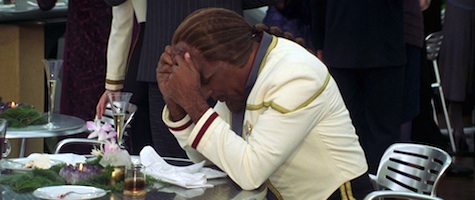
The Enterprise-E sets sail after the reception and Worf argues that it is improper for members of Starfleet to go naked at a Betazoid wedding while everyone tries to forget that Troi has probably already seen Worf naked and vice versa. Picard says they will all follow tradition, essentially ordering them to take their clothes off. (Again, not weird.) Their argument is interrupted by long range sensors picking up a positronic sensor reading on the third planet of the Kolarin system, which borders the Romulan Neutral Zone.
Geordi is reading six positronic signals on the surface but they can’t beam down due to an ion storm. Picard, Data, and Worf take a shuttle down to the surface, and Picard is practically jumping out of his skin to “try the Argo,” which turns out to be a Starfleet standard-issue ATV. Picard promptly does as many donuts as possible before Data protests, at which point Picard rams them through a stack of brush, laughing all the while. (The film for this portion is extremely overexposed and grainy. Assumedly to…set the tone?) Once at the site, the three of them disembark and continue the search on foot.
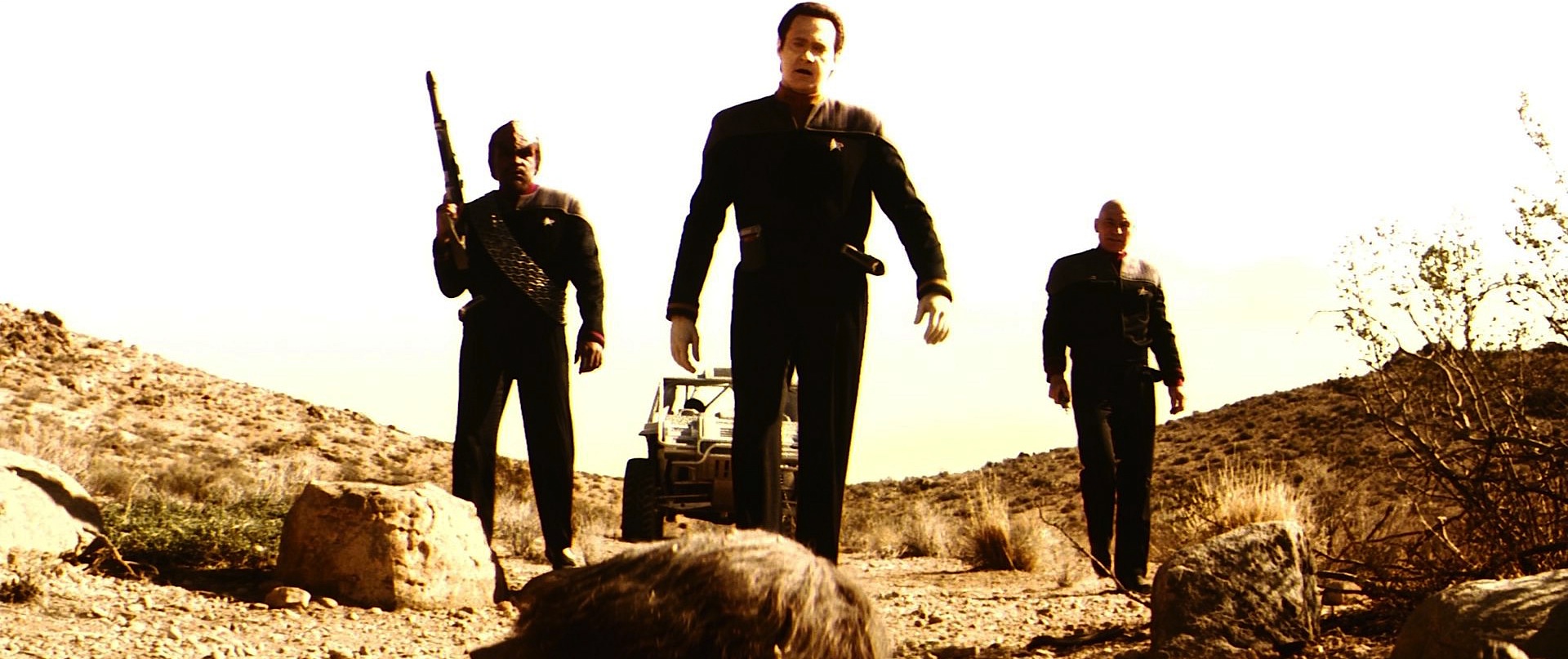
Abruptly an arm emerges from the ground and grabs Worf’s leg, but only an arm, and we see that it is one of the six pieces of an android exactly like Data. Picard is uneasy as they pick up the final piece, the head, which turns out to still be functional (and very chatty). Before they can really process the discovery, Kolarin natives swarm in on jeeps of their own and a chase ensues. Picard eventually drives the Argo off of a cliff and into the bay of their shuttlecraft, a maneuver that is highly unnecessary but proves just how keyed in first officer Data is to his captain’s needs.
Geordi and the crew begin assembling the new android on the ship and they discover that it is a pre-Data and pre-Lore prototype that Dr. Noonien Soong created named B4. Data copies his memory engrams to B4 but the process is demonstrably unsuccessful. The two also discover a redundant memory port in the back of B4’s neck, but are seemingly unfamiliar with film tropes and don’t worry about it overly much.
Their work is interrupted by a hail from Vice Admiral Kathryn Janeway, who orders Picard and the Enterprise to meet immediately with the new Romulan Praetor, a Reman named Shinzon. “The Sona, the Borg, the Romulans… You seem to get all the easy assignments,” she tells Picard, reminding him who mommy is.
Data briefs the crew on the latest news from Romulus, including all they know about Shinzon and the Reman race itself. In the Dominion War, Reman forces were used as assault forces in the most violent encounters. (“Cannon fodder,” Riker comments.) Shinzon himself fought twelve major encounters in the war, winning all of them.
Shinzon keeps the Enterprise waiting for 17 hours, refusing to answer any hails, although Deanna can pick up their cloaked presence. Eventually, Shinzon’s ship the Scimitar decloaks and his Viceroy requests that they beam down to the planet. There, in a darkened chamber, Picard discovers that the new Praetor Shinzon is a human.
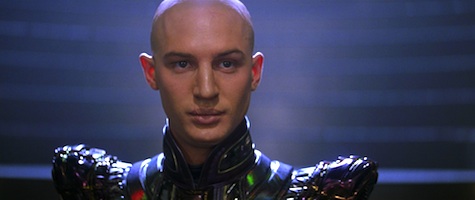
Shinzon gets very distracted by Deanna, asking if he can touch her hair, stating that he has “never met a human woman before,” and just generally being a Professional Level Creeper. Picard gets the meeting back on track and Shinzon reveals that he wants to open relations between the Romulan Empire and the Federation.
The lights are brought up and once Picard can fully see Shinzon the truth becomes apparent: Shinzon is a clone of Picard. Shinzon relates a story about a rare genetic condition that they both have that gives them hypersensitive hearing and continues to hammer home the revelation that he’s a clone of Picard, going so far as to say things like, “Or should I say, that makes only one of us?” (Spoiler: It doesn’t.)
Crusher confirms that Shinzon is a clone of Picard and the Romulan military pester Shinzon for action against the Federation. He yells at them, asking them to learn patience and that “when you spend 18 hours a day under the lash of a Romulan guard you will soon learn patience.” Shinzon dismisses all of them except Commander Donatra, who wastes no time in trying to seduce him. Shinzon reprimands her roughly, stating that she is “not a woman, you are a Romulan” and later telling her that if she ever touches him again, he’ll kill her. As soon as she is outside the chamber, Shinzon nearly collapses. His Viceroy lays a hand on him and Shinzon appears to feel better.
Shinzon and Picard have a tense dinner in the Romulan Senate chambers, which Picard tries to keep somewhat jovial but which Shinzon mostly takes as a chance to taunt Picard. He relates his origins to Picard: He was created by a Romulan government program designed to replace high-ranking members of Starfleet, which was discontinued when the Romulan government changed over. Shinzon was then “discarded” to the dilithium mines on Remus, where the Reman who has become his Viceroy watched over him for 10 years, showing Shinzon “the only kindness I have ever known.” He goes on to explain that every action in his life has been focused on giving the Remans independence. Picard is openly dubious, considering the fairly bloody coup d’etat that Shinzon pulled only days ago but still, Picard continues, gazing at the Romulan Senate chamber, nothing would make him more proud than to accept Shinzon’s overtures of peace…in time.
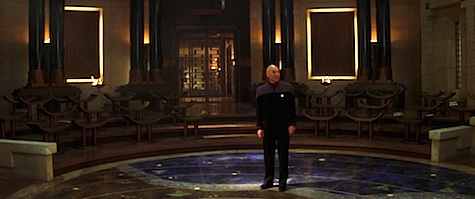
B4 is sitting in Data’s chambers petting Spot when a trojan horse activates in his programming and he begins accessing programs on the ship. Geordi immediately detects B4’s clumsy attempts at hacking the Enterprise computer systems but that’s not the most important thing he’s discovered. While reviewing scans of the Scimitar decloaking he’s analyzed that the Scimitar utilizes thalaron radiation, which can deconstruct organic matter at the sub-atomic level. Picard takes the presence of it as proof that Shinzon does not, in fact, want peaceful relations between the Romulan Empire and the Federation. (In a way that the Scimitar having 52 disruptor banks, 27 photon torpedo bays, and two shielding systems didn’t already convey.)
Shinzon proves this pretty much immediately, mentally invading Troi’s mind (with the help of his Viceroy) to make her see him while Riker and Troi make love. Troi manages to force his presence out but this does not deter either the Viceroy or Shinzon. They are interrupted by a report that a transponder signal has been received, which turns out to be a beacon that B4 has activated. B4 is transported to the Scimitar and brings data that reveals the position of the entire Federation fleet.
Troi is in sickbay being examined. Visibly shaken by the violation, she requests to be relieved of duty. Picard refuses, citing that she is too valuable to him and that he wants her to “endure more assaults” as a way of maintaining contact with Shinzon’s forces. Riker, Troi, and frankly the viewer, are stunned but before they can protest Picard is beamed away by Shinzon and imprisoned. Picard’s blood is drawn and Shinzon prattles on some more about being alone and not quite human before dismissing B4 and walking out.
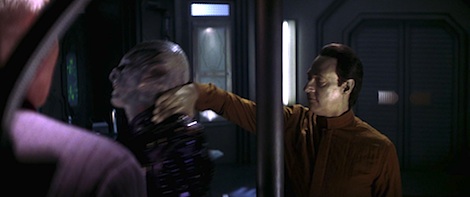
B4 returns to Picard’s cell and tells the guard that Shinzon needs him free, at which point B4 smirks and neck pinches the guard. B4 reveals himself to have been Data the whole time and gives Picard an Emergency Transport Unit prototype so that he can beam out of there. Picard refuses, since it can’t beam Data back as well, and they make for the Scimitar’s shuttle bay.
Their ruse is discovered along the way and a shoot-out ensues. Data and Picard get inside a Scorpion-class attack fighter but can’t get out of the shuttle bay doors due to the Remans erecting a force field. So they fly the fighter back into the ship’s corridors, mowing down any Remans in their way and banging against nearly every wall. The fighter bursts out of a porthole, breaking the ship’s cloak and making the Scimitar visible. Riker beams the shuttle into the Enterprise just in time and they warp back towards Federation space.
The Romulan military loses faith in Shinzon’s abilities but Shinzon reveals that he will release thalaron radiation over the entire Earth in two days, wiping it clean of life. He is visibly sickly and after Shinzon signs off the Romulans begin discussing his visible bio-degradation. On the Enterprise, Crusher reveals that Shinzon’s growth was accelerated, which is why his body and mind are breaking down, and that he needs a complete transfusion of blood from Picard to live.
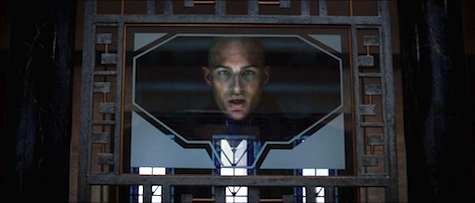
Picard informs the crew that they are making their way to Sector 1045, just on the other side of the Neutral Zone, where they will stop to confront Shinzon and the Scimitar with the aid of the fleet. Shinzon rushes after them, having only hours until his body breaks down completely.
In the lab, Data interrogates B4 before shutting him down, although at no point does B4 understand what’s happening. Picard and Data then get into a discussion regarding their doubles. Data is absolutely certain that he is different than B4 because he aspires to be more and his experiences in life have shaped him differently. Picard is not certain that he would be different if he had experienced Shinzon’s life.
The Scimitar ambushes the Enterprise in the Bassen Rift, disabling its warp engines immediately. The ship can fire while cloaked (surely not!) so Picard orders the Enterprise to just fire wildly to determine its location. It works, but doesn’t keep the Scimitar off of them.
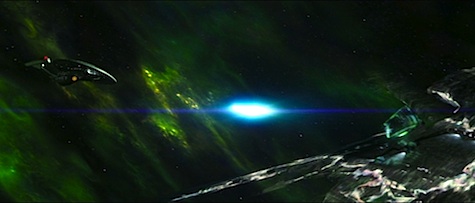
Shinzon ceases firing for a moment to appear via holographic emitter in Picard’s ready room, urging Picard to beam over so Shinzon can complete the procedure. Picard turns the tables and urges Shinzon to become a better person, as Picard himself did, since they both possess the same faculties. He attempts to convince Shinzon that he now has a future that he is free to mold instead of “wasting it in a blaze of hatred.” Shinzon is repelled and resolves to destroy Picard.
Abruptly, two Romulan warbirds decloak and Commander Donatra offers her assistance in combatting Shinzon. The firefight begins anew but one warbird gets destroyed, with the debris impacting the Enterprise and damaging it further. Shinzon purposefully decloaks a part of the Scimitar, feigning damage and luring in the remaining warbird. The Scimitar cripples the warbird, though Commander Donatra survives.
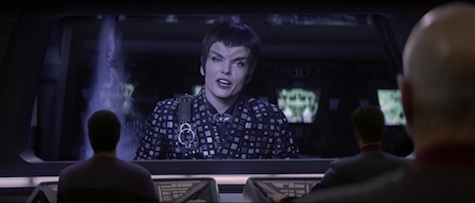
Shinzon’s condition is getting worse by the minute and he halts the Scimitar’s attack momentarily. Troi uses the connection that Shinzon and the Viceroy forced on her earlier in the film to invade the Viceroy’s mind and locate the still-cloaked Scimitar. She succeeds at locating Shinzon’s ship and disabling their cloak.
The Remans beam a boarding party on to the Enterprise and Riker and Worf lead a team to stop them. “The Romulans fought with honor,” Worf admits, perhaps rethinking a lifetime of prejudice, just before a shoot-out in the corridors ensues. The Viceroy leads Riker into the Jefferies tubes in order to ambush him, which works, and the two of them fistfight through an Enterprise that seems to be nothing but catwalks and pits.
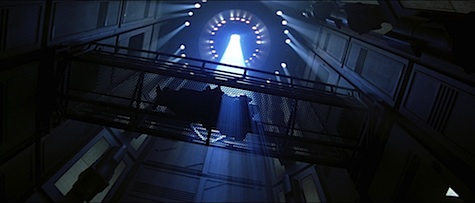
Meanwhile, a new volley from the Scimitar tears open the bridge itself, blowing away the viewscreen and sucking the helmsman out into space. All seems lost, as the Enterprise is out of photon torpedoes and phaser power while the Scimitar’s shields are still at 70%. Shinzon opens a channel and asks Picard to surrender himself. Picard keeps Shinzon talking long enough to disguise the fact that he is ramming the Enterprise right into the Scimitar.

The impact is suitably apocalyptic and Shinzon begins the screeching process of unpeeling the two ships from each other. The additional turbulence from that ends up sending Riker and the Viceroy tumbling around on the catwalk that they’re fighting on and Riker kicks the Viceroy until he plummets to his doom.
Picard attempts activating the self-destruct on the Enterprise, but it’s offline due to the damage to the ship. Shinzon responds in kind, activating the thalaron radiation emitter.
For some reason, Picard transports over to the Scimitar, but the strain on the ship blows out the Enterprise’s transporters. Data gets angry, tells Troi she has command of the ship (even though Riker is still alive…) and basically jumps through space from the Enterprise to the Scimitar.
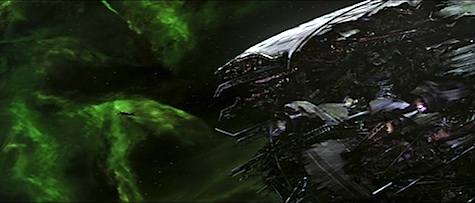
Picard fights his way to the Scimitar bridge with three minutes left on the thalaron emitter countdown and he and Shinzon grapple, despite Shinzon looking like something out of The Walking Dead at this point. Picard’s lost his phaser and Shinzon has A Buncha Knives, but Picard manages to impale him on a piece of the set regardless. Shinzon, ever the asshole, pushes the wall spike further into himself so he can spit his last words in Picard’s face. “I’m glad we’re together now. Our destiny is completed.”
There is only one minute left in the thalaron radiation firing sequence when Data arrives. Before Picard can react, Data slaps the Emergency Transport Unit on him, whispers goodbye, and fires into the radiation emitter, exploding the Scimitar.
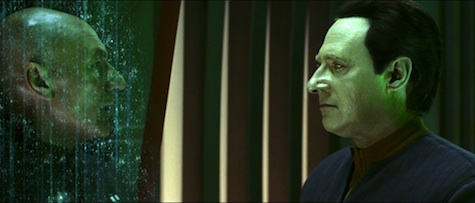
Picard arrives back on the Enterprise’s bridge just in time to see the explosion. Geordi and Troi are overjoyed to see him, then realize Data isn’t with him. Romulan Commander Donatra hails them, tells Picard that he’s earned an ally in the Romulan military, and sends over shuttles with medics and supplies.
Picard opens a bottle of, appropriately, Chateau Picard, and the senior staff raises a glass to Data’s memory. Riker reminisces about the first time he met Data, on the holodeck during their Farpoint mission, but can’t recall the tune he was trying to whistle. (While the audience screams, “It was ‘POP GOES THE WEASEL,’ ASSHOLE.”)
The Enterprise is being repaired over Earth and Riker requests permission to disembark to the Titan. Picard then sets himself to explaining Data’s loss to B4 who, par for the course, doesn’t understand. As Picard departs, B4 begins singing snatches of “Blue Skies,” giving Picard hope that Data may yet be returned to them.
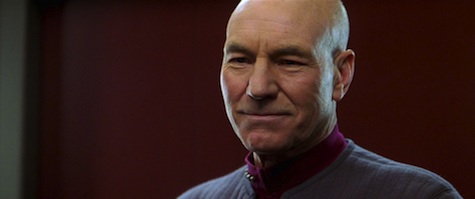
Thank You, Counselor Obvious: Poor Troi gets her ass handed to her in this movie. Although Star Trek Nemesis opens with Picard praising her as his conscience, at no point during the ensuing story does he ask her reading on Shinzon or how his judgment might be clouded by the personal nature of the events. (The one scene where he did was deleted from the final film.) She is subsequently mind-raped by Shinzon and his Viceroy, to which Picard is essentially unsympathetic, calling on her to continue to invite further violations so that they have a back-door avenue of attack.
Her retaliation against the Viceroy is satisfying (“Remember me?”) and Marina Sirtis gives that moment her all, but it ultimately serves to underline how poorly the filmmakers treated her character. A deleted scene from the movie features Troi being attacked in the turbolift a second time by Shinzon and the Viceroy and in the introduction to those deleted scenes on the DVD, director Stuart Baird goes out of his way to say how much he regrets losing Troi’s second rape scene.
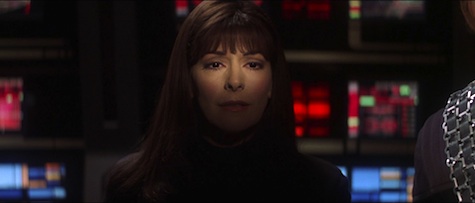
Can’t We Just Reverse the Polarity?: Shinzon’s ultimate weapon is thalaron radiation, which must be an as-yet-undiscovered fifth type of radiation (There are four types of radiation: Alpha, Beta, Gamma, and X. I suppose the fifth type must be Bullshit.) Thalaron radiation can tear apart organic matter at “the sub-atomic level” which is so wrong it actually stumbles backwards into being correct, since radiation is essentially the jumping of sub-atomic particles from one place to another.
Geordi also mentions that the Scimitar’s cloak “is perfect” and we later discover that the Remans have re-engineered the technology to fire while cloaked that we saw in Star Trek VI: The Undiscovered Country.
Positronic sensor readings can be detected light years away, which makes Soong’s androids very special indeed.
There is No Honor in Being Pummeled: This is the first Star Trek movie to take place after the events of the Deep Space Nine finale “What You Leave Behind,” which sends Worf off to be the Klingon ambassador to the Federation. Here he’s back in Starfleet and back on the Enterprise with no explanation. (Also still a Lieutenant Commander, which would make no sense even if they had explained his presence.) His duties on the Enterprise-E aren’t explained in the film but since he accompanies Picard and Data to Kolaris and heads a team to confront the Remans on the ship, one assumes that he is back in charge of security.
No Sex, Please, We’re Starfleet: Riker whispers “imzadi” to his wife while they make love. It’s a sweet aspect of their long-standing relationship—finally made canon!—that Shinzon immediately poisons.
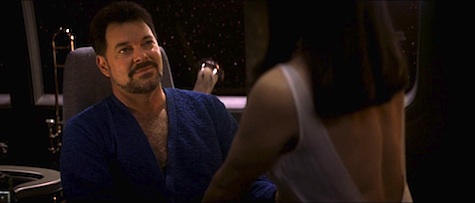
The Boy!?: Though not on screen in the final cut of the film, Wesley can be seen in Starfleet dress uniform during extended scenes from Riker and Troi’s wedding. (His rank indicates that he is a junior grade lieutenant.)

If I Only Had a Brain: B4 is yet another long-lost son of Soong, although his intellect is markedly childlike. It’s unclear as to whether Soong actually constructed B4 or whether the Romulans simply stole Soong’s prototype schematics during the same time they were cloning other Starfleet officers. The latter would make more sense, since Shinzon was able to get his hands on him prior to the events of the film.

Despite B4’s presence, Data is remarkably straightforward on how he wants to treat his new brother and while Brent Spiner’s acting indicates that Data has achieved a very precise control over his emotions (Data’s interrogation of B4 is chilling, as Data is both genuinely sympathetic towards B4 and unrelenting in his questioning.) it’s never stated that Data is even using his emotion chip. In fact, while transferring his memory engrams to B4, Geordi asks him how he feels, to which Data replies, “I feel nothing.”
First Contact saw Data’s emotion chip integrated into his systems, while Insurrection sidestepped the issue by noting that Data “didn’t take it with him” on the Ba’ku mission. Has Data abandoned the emotion chip altogether by the events of Nemesis? Was it standing in the way of his promotion to first officer?
In the Driver’s Seat: Lieutenant Branson is the unlucky sod in the driver’s seat when the viewscreen is blown off. He gets sucked into space before a force field can be erected.
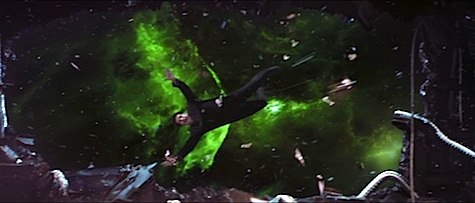
I Believe I Said That: “Ladies and gentlemen and invited transgender species…”—Data, casually including an aspect of the final frontier that Star Trek: The Next Generation has historically been quiet about.
Welcome Aboard: Tom Hardy plays our movie’s villain, and Picard’s supposed opposite, Shinzon. These days he’s more familiar to the world as Batman’s nemesis Bane and you can readily tell which aspects of Shinzon were basically a dry run for his role in The Dark Knight Rises. Ron Perlman is utterly wasted as Shinzon’s mostly silent Viceroy. The treacherous Senator Tal’aura is played by a returning Shannon Cochran, who played Martok’s wife Sirella on Deep Space Nine. (A fact lovingly jabbed at by Keith in Your Favorite Star Trek Rewatcher’s book Articles of the Federation.) Whoopi Goldberg returns as Guinan and Wil Wheaton returns as Wesley Crusher, although we’re not sure what either has been up to in the interim. Kate Mulgrew reprises her role as Captain Kathryn Janeway, although now she’s sporting some Vice Admiral pips and cleaning up the Alpha Quadrant’s messes. (She’s also gone Back to the Bun.)
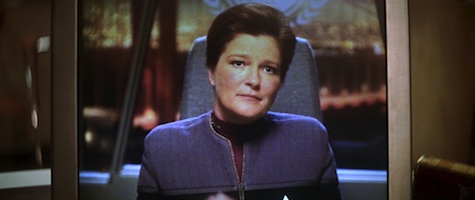
Dina Meyer portrays the olive-branch-extending Romulan military commander Donatra and makes a surprising impact considering how small her role is. Sci-fi fans probably recognize her first as Dizzy Flores from the first Starship Troopers movie, although she’s been in a good number of the Saw films, as well. Steven Culp gets left on the cutting room floor as Commander Martin Madden, Data’s replacement as first officer on the Enterprise. (Although that’s probably just as well considering how wooden and odd his performance comes out as.) Culp would get a better chance to earn his Star Trek wings portraying Major Hayes starting in the third season of Star Trek: Enterprise.
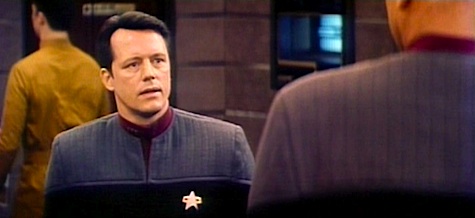
X-Men director Bryan Singer is apparently a big Star Trek fan, so Patrick Stewart snuck him in as an extra. (He replaces a bridge crew member on tactical.)
Trivial Matters: Although Nemesis didn’t bother to explain the presence of many of its main characters, there are a lot of references to the larger Trek universe peppered throughout. Riker orders the Enterprise into “Defensive pattern Kirk Epsilon” during the battle in the Rift, the Dominion War is referenced early on, Janeway is the one who sends the Enterprise on its mission, and the U.S.S. Archer is one of the ships scheduled to meet up with the Enterprise in Sector 1045.
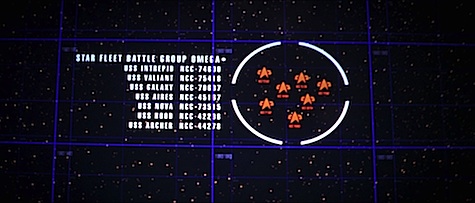
Wil Wheaton was apparently added to the film at the last second, at LeVar Burton’s urging, and had no idea if he would have lines, what scene he would be in, or what the status of his character was. Patron saint of Tor.com Denise Crosby asked Rick Berman if there was an opportunity for Sela to reappear, but was told it didn’t fit the story. (Which isn’t true at all. Having her be the Romulan military commander urging the Senate to accept Shinzon would have made perfect sense, given her loathing of Picard, and would have made Donatra’s overtures later in the film stand out more in juxtaposition.)
Outlined in the script but not appearing in the movie is the information that Beverly Crusher left the ship to become head of Starfleet Academy Medical Division shortly after the events of Nemesis. The A Time to… series of Star Trek Pocket Books explains the events leading up to this film, including Keith R. A. DeCandido’s A Time for War, A Time for Peace, which explains why Worf was back in Starfleet.
Via Keith’s comment below: “The movie’s many followups in novel form include the TNG novels Death in Winter, Resistance, Q&A, Before Dishonor, and Greater than the Sum, the series of Titan novels, starting with Taking Wing, and my political novel Articles of the Federation.”
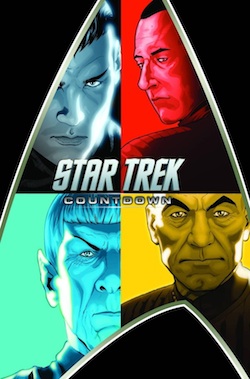
The events leading to the reboot universe depicted in 2009’s Star Trek were depicted that year in a four-issue comic series from IDW titled Countdown, which takes place eight years after the events of Nemesis. The comic “reveals” that Data’s memory engrams eventually emerged from B4’s neural net and that the newly revived Data went on to become captain of the Enterprise-E following Picard stepping down to become Earth’s ambassador to Vulcan. Riker, Deanna, and the crew of the Titan are depicted as being instrumental in the reconstruction of the Romulan Empire and are credited with opening up relations between Earth and Romulus to an unprecedented extent. Worf has become a Klingon general. (Which seems to be a fast-track to leadership of the Empire. Just ask Gowron or Martok.) Geordi is revealed to have retired from Starfleet to design his own ships, including Ambassador Spock’s Jellyfish, the ship Spock eventually travels back to the 2009 Star Trek timeframe with.
By his own account, Picard has made first contact with 27 alien species, most notably the Ferengi (“The Battle” or “The Last Outpost” depending on your definition of first contact), the Borg (“Q Who”), and the Q (“Encounter at Farpoint”). Unfortunately for Picard, all three of those species are fascinated with him in ways that turn out to be deadly for those around him.
Picard reveals that it is customary for the male to take the surname of the Betazoid woman that he is marrying. It is never stated whether Deanna’s human father Ian took Lwaxana’s name, but considering Lwaxana one would be hard-pressed to bet against it. (This also means that Riker and Deanna’s firstborn will carry the Troi name, which probably means Riker will get to choose the first name and since this is Star Trek he’ll probably use the name of a famous jazz musician. So I’m sorry, Dizzy Troi, but your life will never be easy.)
During their Senate chamber dinner Jean-Luc reveals to Shinzon that he was the first Picard to ever leave the solar system. Considering that his family was killed in a fire in Generations, he’ll probably also be the last.
Guinan offhandedly reveals to Geordi that she’s had 23 husbands by the late 24th century events of Nemesis. Considering that we know she’s been an adult for a span of roughly 500 years, that means she gets married on average every 21 years. (There have been 15 years between “Encounter at Farpoint” and Nemesis, meaning she’ll probably be due for another go-round soon. So, Geordi, as Data might say, “Saddle up. Lock and load.”)
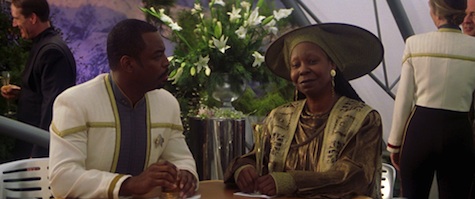
Patrick Stewart is an outdoors enthusiast and the Argo chase sequence was bulked up to give the actor something fun to do in what was otherwise a heavy film. Stewart took racing lessons to prepare and during the filming really put his co-stars through the ringer, at one point telling Brent Spiner, who kept getting smacked by branches and brush that “You’re an android, you don’t feel these things.”
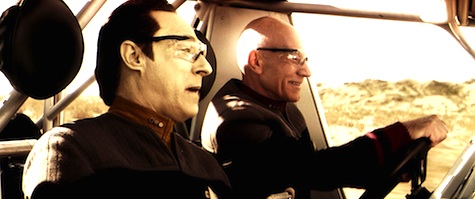
The original script draft for Nemesis was over three hours long and the film itself was shaved by another 17 minutes. These deleted scenes were included in the home DVD release of the film and included many one-on-one scenes between Picard and his crew, including Data, Beverly, and a particularly revealing conversation between him and Deanna where Picard reveals just how freaked out Shinzon makes him. The deleted scenes also include an extended ending with Riker tricking the new first officer Madden into being overly familiar with the captain, which Patrick Stewart plays beautifully, never cracking a smile and letting Madden’s discomfort sit and sit and sit there. Picard tests out his new captain’s chair, as well, which “finally!” comes equipped with emergency seatbelts. While it’s a shame we never got to see Picard’s next first officer, you can tell the lighthearted banter was not a great note to end The Next Generation cast’s final film with.
Make it So: Damn, but this is an exhausting movie. Now over ten years old, Nemesis’ place in Trek history is seen as indisputably ignominious. A needlessly dark, off-key Trek film that signaled the death knell of the Star Trek movie franchise, as well as any chance we’d have of seeing the Next Gen crew in action again.
I’d love to say that time has been kind to Nemesis, though it isn’t quite as bad as I remembered it. The Argo scene doesn’t drag as much and some of the action sequences are genuinely thrilling. Flying the shuttle through the Scimitar’s corridors and out of a window is clever, exciting, and a cheeky commentary on a show that is classically nothing but corridors. Picard smashing the Enterprise-E into the Scimitar still gives me a shiver, and I find it funny that while we’ve seen Worf threaten to do that, Picard just does it. The viewscreen being blown off is terrifying and Data jumping across space to get to the Scimitar is just plain cool.
But. None of that can elevate the material beyond the deep, intrinsic flaws of the film. Much has been said (hilariously so) about Nemesis’ aping of The Wrath of Khan and to this day it is astounding that the setting and the characters of Star Trek: The Next Generation could be so misunderstood. The concept of Shinzon is agonizingly forced. We are expected to believe that Picard cares about his clone when that same clone exhibits none of the traits that captivate us about Picard. Even aside from that, Shinzon is a poorly conceived plot device; a character literally grown to give Picard his version of Khan, and one who defies the logic of his own story to suit the needs of the overall plot. (We never find out why he wants Earth destroyed, and he refuses the treatment that will cure him three times in the interest of taunting the characters.) Picard’s character has to stretch to accommodate this story, a story so big that it sidelines every other character except Data, and yet by the end of the film we’re left with less than what we started with. We’ve learned nothing new about Picard, or Data, and half the crew is now gone.
It was obviously intended for the story of Data’s duplicate to run in parallel with Picard, but B4 is never given any characterization and Data has barely any interaction with him. (In fact, Picard and Data only discuss the entire thing once, an hour into the movie.) B4 is another plot device, same as Shinzon, existing solely to propel the plot forward. It makes you wonder, if they had to make the movie this way, why didn’t they just use Lore? He at least has a history with the crew and an often-misguided agenda. It would have even played into Nemesis’ weak Khan theme of how the sin of neglect can return to haunt you.
Instead, Nemesis gives us no theme at all. No message beyond “a duplicate of yourself can be a real asshole.” Or possibly, “A great crew is like family. So it sucks when your asshole duplicate starts raping and killing them.” Nemesis is an okay action flick, but unlike other action flicks it has a responsibility to the history and the unique message of Star Trek. Especially when you consider that the filmmakers and cast knew going in that this was going to be the final Next Gen film. There is nothing in Nemesis about humanity bettering itself and helping others in need. Nothing about exploring boundless new frontiers. There are no hard choices here, and no mistakes to atone for. There’s just a crazy guy tearing things apart for no reason. Also, Shinzon.
In the end, Star Trek Nemesis makes fans of Star Trek: The Next Generation feel like crap. We leave Picard, and the half of the crew that survive and don’t leave, at their lowest point. Star Trek: The Next Generation was a breath of fresh air when it arrived in the late 1980s. It was a vibrant revival of a beloved series and gave fans the opportunity to continue exploring a galaxy that they had dedicated their lives to. It introduced a new generation of science fiction lovers to the ideals of Gene Roddenberry and as the years went on the popularity of Next Gen proved, without a doubt, that those ideals resonated deeply for a great many people.
The actors, creators, writers, and crew of Star Trek: The Next Generation essentially saved Star Trek from fading into history. And that’s ultimately why Nemesis is such a spectacular failure. Because it denied these characters, this generation, the respect that their final outing truly deserved.
Warp factor rating: 1
Note: I owe a big thank you to Your Regularly Scheduled Star Trek Rewatcher Keith DeCandido for letting me bite his style for this rewatch of Nemesis. As the deadline for this piece neared it felt innappropriate to finish the Next Gen rewatch any other way.
We’ll see you next week! Say… 1500 hours? Quark’s? You’re buying.
Chris Lough is the production manager of Tor.com and has donated his copy of Star Trek Nemesis to a really great fire.










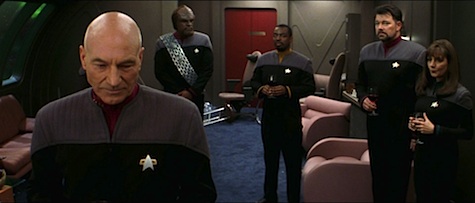

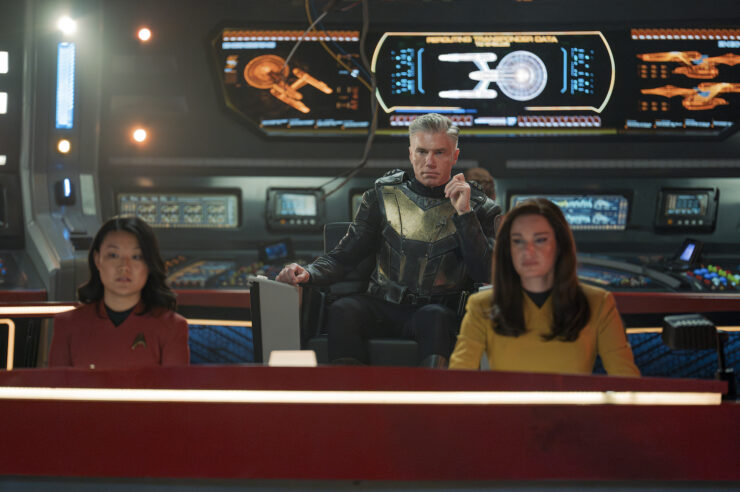
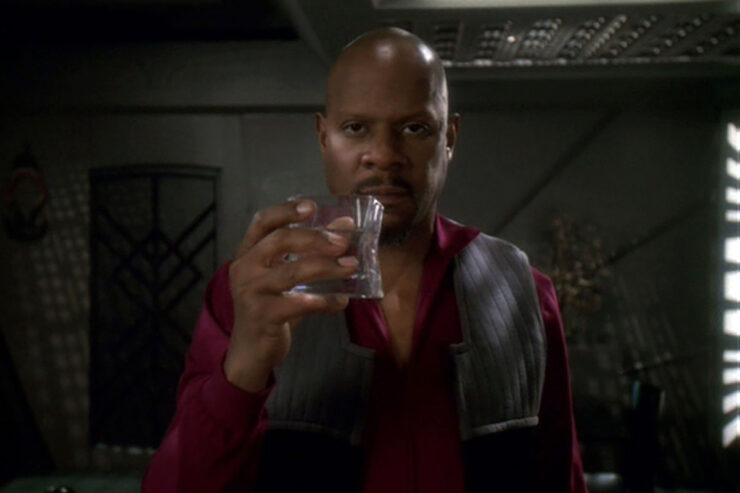
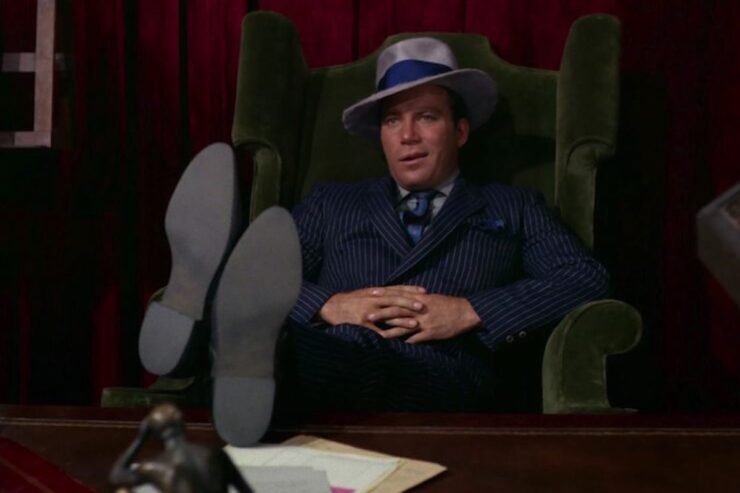
Agreed on all counts. This movie was pointless and senseless, the only installment in the Star trek movie franchise less watchable than TMP. And in a franchise containing both Star Trek V & Insurrection, that’s saying something!
Huh – I had no idea Wesley was even in the extended version. I guess moving around on higher planes of existence can get you promoted to Lt jg without graduating from the academy. who knew?
@2 Maybe he was just promoted to ‘acting Lt j.g.’
In my head cannon this movie never happened. It’s the only way I can think about the end of Next Gen without rage.
I remember when the film was in production and i read a blurb in the paper about how they had gone back on location to film extra footage for a chase sequence involving ground vehicles. I groaned and said “Great, Just what Star Trek has always been missing; a car chase scene.” That was when I knew it was going to be awful.
Uhm, no. The A Time to… series chronicled the year leading up to this movie, and my finale ATFW,ATFP explained why Worf was back in uniform in this film.
The movie’s many followups in novel form include the TNG novels Death in Winter, Resistance, Q&A, Before Dishonor, and Greater than the Sum, the series of Titan novels, starting with Taking Wing, and my political novel Articles of the Federation.
—Keith R.A. DeCandido
Every time I watch this movie I say “damn”. Damn because it should have been a wonderful send off. Instead, it’s a complete mess. Perhaps Stuart Baird or someone could go back, re-edit the film and create a new cut. Re-editing did wonders for The Abyss and Alien 3.
@6 haha i was wondering if you would call him out on that.
1500 hrs quarks, ill be there. Just one question, Chris, 1500 vegas time? 1500 New York time or bajoran time?
Im thinking ill get a warp core breach and yammock sauce…
When I saw the movie, and saw B4, I kept saying to myself. “Lore, Lore, what the heck about Lore?” Its almost as if he never existed in the universe of this movie. Its as if this movie takes place in a parallel Star Trek universe. It might explain the Worf and Crusher things, too…
I’m one of the few people, it seems, who really like Nemesis. Oh, I agree it has problems. The whole dune-buggy chase was a completely pointless bit of action, part of the problem I complained about in the Insurrection rewatch about how the films were forced to tack on action beats because of the cultural prejudice that SF films have to be action rather than drama. And conversely, a vital scene between Picard and Data which set up so much of the thematic and character arcs for what followed was completely cut out because of “pacing.” And there are very problematical elements like why Picard didn’t see it coming that Shinzon would attack the moment they entered the nebula that would cut off their communications, or the whole thing with the tiny portable transporter. (Are we supposed to believe the transporter is actually inside that teensy thing? How can a transporter dematerialize itself and still function? I’d like to think it was just a remote control for the Enterprise transporters, but they were said to be offline.)
But there’s a lot about this movie that I think is smart and well-done and I think it redeems most of the rest. In particular, I think the Picard-Shinzon relationship is the best captain-antagonist relationship in all the Trek movies. Talk of clones aside, it’s really a father-son narrative at its core — Shinzon is the son Picard never had, but he resents and rebels against his “father”‘s attempts to shape and guide him because he chafes at living in his father’s shadow. That’s why he tries to destroy Earth, as he specifically explains in dialogue: because he wants to overshadow Picard and erase his accomplishments from history. He doesn’t believe he can really be himself until he destroys the man he’s a copy of, and destroys his legacy as well. Sure, it’s a contrived way to inject a threat to Earth in the movie, but it still has a character-based justification that I’m okay with.
And it’s the interplay between two strong actors, Stewart and Hardy, that makes it really compelling. One may quibble about Hardy not really resembling Stewart, but that’s just theater. They’re actors playing roles, and we suspend disbelief. It’s the performances that matter, and the interplay between these two men is intriguing to me. Certainly much more intriguing than the confrontations in The Wrath of Khan where the screenwriters couldn’t even figure out a way to structure the story that allowed the hero and villain to be in the same room at the same time.
Along with INS, it’s also one of the few Trek movies to try to explore the kind of philosophical questions the shows explored. In this case, is it nature or nurture that determines our identities? Would we be the same people if our upbringing had been different? Are our actions really a matter of free will and choice, or are they dictated by the conditions that shaped us? That’s where the optimistic, Trekkish message is, the statement about human betterment. Shinzon makes excuses for his evils, blaming them on his past or his circumstances or on the Romulans or on Picard. And so he’s trapped, unable to change because he denies responsibility for his own actions. But Picard and Data recognize that they can choose to become better people by constantly working to improve themselves. And that’s the whole message of the Trek franchise — that humanity can choose to make itself better, that we’re all fallible and have a dark side but we can rise above it as long as we keep striving toward our ideals.
I don’t have a problem with not using Lore or Sela, because movies have to be accessible to the general audience, not just continuity junkies. Both characters had too much backstory, which would’ve taken too long to explain and distracted from the film’s story. (Plus, Sela was a horrible idea from the start.)
Presumably the overexposure on Kolarin was meant to represent the planet’s sun being brighter or nearer than ours. It’s the only thing about that sequence I appreciate.
B-4 singing “Blue Skies” wasn’t really meant to represent the possibility of Data’s resurrection. Brent Spiner intended this to be his last ever appearance as Data since he felt he’d aged out of it, and the movie went to great lengths to make it clear that B-4 just couldn’t function on the same level as Data, even with Data’s memories. The song was just meant to represent the hope that what Data left B-4 could allow him to achieve the personal growth that he’d been incapable of before. Certainly the studio wanted it there as a backdoor for bringing Data back in a later movie if NEM did well enough to justify it, but that was a secondary purpose for the scene, not its primary one. But nobody understands that, because resurrection has become such an overused cliche that everyone expects it now.
It’s worth noting that NEM was Jerry Goldsmith’s final Trek film score, and the second-last feature film score of his life (the last being Looney Tunes: Back in Action — another film I probably have a higher opinion of than most people do). And I think it’s one of his best Trek scores — although, really, they all are. Well, it’s better than INS and at least as good as FC (much of which was actually by Joel Goldsmith).
See, I thought this film had a perfectly appropriate (and perfectly Star trek) theme: are we simply the result of the things that happen to us (Shinzon’s excuse for his cruelty, treachery, and bigotry), or do we have the capacity to choose to be better (as Data believes, and as Picard argues)?
Really, the only way I would’ve expanded on it would be to have Worf more visible –as you note, he effectively rethinks a lifetime of racism in this movie. Unlike Data & Picard (who, as per Shinzon’s counter-argument, have had every “lucky” break in their upbringings), Worf becomes a better person in spite of his negative experiences with Romulans.
My roommate and I went to see this our sophmore year at college, and had the entire theater to ourselves. On a friday night. That tells you (and it told us!) everything you need to know about the movie.
Thanks, Keith. It’s been fixed.
My initial reaction, in theaters, was that this was a great movie. My subsequent reaction is a little like being hungover. Great idea at the time, seemed fun, but in hindsight, not so much. Seriously, there’s nothing forgiving about this movie.
No. Let us thank you Chris for using the stnd krad format. It’s a shame that Ryan and Emily didn’t, as it considerably shortened two otherwise good & interesting reviews. Which begs the question Keith – were the TNG movie reviews dished out to mutiple writers in accordance with peoples’ work demands/schedule or was there some films that were passed on as you really, really couldn’t stomach rewatching it! :)
@12 Sophomores in college and you and your roommate went to see it on a Friday night? That tells more about you than the movie.
@10, I agree with everything you said, even the part about Looney Tunes(there are SO MANY LAMPSHADES).
Hardy was the best villain performance in Star Trek, hands down. Shinzon may have been a cardboard cut out, but Hardy breathed life into him, made you feel for him even as you abhorred him. That was worth something.
Wasted opportunity was my original reaction to Nemesis, and despite the passage of years and revised reflections on the other movies (*) – wasted opportunity still remains my main view on this film.
(* such as an increased enjoyment of Insurrection. ‘Feels like a series two-parter’ has gone from a negative to a positive; especially after this rematch has reminded me of all the little things and its own character within the franchise, that made TNG so great)
http://redlettermedia.com/plinkett/star-trek/
i just wanted to leave a link to redlettermedias excellent star trek reviews
@@@@@ 10. Gonna have to disagree with you on the final B4 & Picard scene. Doesn’t matter what Spiner or the original script intended, the scene as presented in the final product totally plays as ‘B4 is going to become Data & isn’t that GREAT?!’.
And the answer to that is a big giant NO! It is creepy, frelled up & anger making.
It’s clear Stuart Baird didn’t have a grasp on the ‘Trek universe. I’ve long wished they would give Frakes some money and time to reedit Nemesis as I think there is a better film in the footage.
Even before being spoiled on opening night it seemed like Data had a death wish in this movie. That feeling detracted from my enjoyment more than anything. That Brent Spiner was so adamant that he was too old to play Data never really added up to me. Wasn’t there a reference in the run of TNG that he was updating his appearance to give the impression that he was aging? An aged appearance could easily be explained as a deliberate effort to make those arround him feel more comfortable, or to be part of his human journey. I’m saying killing Data can’t be a valid creative choice, but it seemed like it was don’t for a shallow reason and that leaked through into the story.
It could have been worse…we could have gotten a wrath of Damon Bok story. Overall I don’t really hate this movie and I don’t hate TMP either. I would say that I am least interested in watching V & VI more than any others which I guess makes them my least favorite.
@20: “Doesn’t matter what Spiner or the original script intended, the scene as presented in the final product totally plays as ‘B4 is going to become Data & isn’t that GREAT?!’.”
I’m not talking about the original script, I’m talking about everything the actual, final film said about B-4 up until that point. Data tried uploading his memories into B-4 in the hopes that it would spark his development — and it failed. Geordi even said “Maybe he’s not supposed to be like you, Data. Maybe he’s supposed to be exactly the way he is.” Later, once B-4 had become a threat, Data shut him down with the intention that it would be permanent. He then said to Picard, “The B-4 is physically identical to me, although his neural pathways are not as advanced. But even if they were, he would not be me… I aspire, sir, to be better than I am. B-4 does not.” Thematically, the whole point of the B-4 character was to parallel Shinzon. Both Picard and Data met their reflections, both of them hoped they could nurture those other selves and help them fulfill their potential the way Picard and Data had, and both of them failed utterly because their other selves were too incapable of growth. The fact that B-4 couldn’t become Data was the whole point of his presence in the film, dramatically and thematically.
So seeing that one last scene and thinking it means “Oh, he’s going to turn into Data” requires ignoring everything we’ve been told and shown about B-4 for the previous hour and a half. The problem is that people seeing that scene aren’t judging it in the context of Nemesis, but in the context of The Wrath of Khan/The Search for Spock.
Although it should be noted that when TWOK’s makers inserted the shot of Spock’s intact tube at the end of TWOK, they had no actual expectation or knowledge that Nimoy would be coming back for the next film. As far as they knew at that time, Spock was going to be dead forever. The shot of the tube was just inserted to end the film on a more upbeat note, to give moviegoers a glimmer of hope so they wouldn’t leave the theater depressed. The final B-4 scene here was the same sort of thing — just a glimmer of hope so the film could end on a more upbeat note. But resurrection has been so grossly overused as a plot device these days that audiences have come to expect it, to feel they’re entitled to have dead characters returned to them. And that overall cultural climate — which TWOK/TSFS certainly had a hand in creating — made it impossible for audiences to read the scene the way it was meant to be read, even though it meant ignoring the evidence of the rest of the movie.
(And let me be clear: Yes, obviously the studio intended it as a backdoor for potentially bringing Data back. But as I’ve already said, that was secondary. That was what the studio wanted, not what Spiner, Logan, and Baird wanted or what was set up in the film itself.)
… and then Picard(‘s clone) wound up in a romantic comedy with (alternate timeline) Kirk.
“Picard keeps Shinzon talking long enough to disguise the fact that he is ramming the Enterprise right into the Scimitar.” Dangit, they just got this ship.
“As Picard departs, B4 begins singing snatches of “Blue Skies,” giving Picard hope that Data may yet be returned to them.” Data downloaded all of Lal’s memories and personality, but her persona never appeared again. And Data was her father – if it could have worked, he would have made it happen.
@10: Loved Looney Tunes. And I like Nemesis, flaws and all. I thought the final scene opened up alot of possibilities to the imagination. B4 was a developmentally disabled member of a sentient species, and his sole family member had just died. He would have been a ward of the state. Would Captain Picard take on his care, instead? I knew that if the series continued the producers probably would have retconned it so Data lived, but somewhere in my head, B4 resides on earth, tends to grapevines, and takes care of his brother’s cat.
I started reading this review, thinking I had seen all the Next Generation movies, only to realize that I missed the last of them. That is probably an indication of just how much Insurrection disappointed me. Given the commentary above, sounds like I didn’t miss much.
@24: You hit upon just how distasteful the idea of Data “taking over” B-4’s body really is. B-4 was essentially a person with a severe learning disability. That didn’t make him any less a person or any less entitled to the right to live his own life. Fortunately, the novels have acknowledged this and let B-4 be his own person rather than having Data essentially murder him by displacing his consciousness.
@26, I’m actually really glad that later works acknowledge that B4 was an entirely separate character. My impression was that Data hadn’t intended murder, but had hoped to help B4 develop and grow using his own more advanced mind as a blueprint. It seemed he’d also left his own memories as a record for his brother to keep. But it is obvious how those intentions could be perverted by either grieving friends or an eager admiral.
The only part of this movie I like is the wedding. I hate the rest with an absolute passion. B4 maybe a seperate person from Data, but I still watched it and thought okay they left a trapdoor in for him come back in some fashion even if he doesn’t overwrite his brother. Nemesis is my most hated Star Trek film even more than V. To top it off it lets the series of movies end on a dark depressing note. I wasn’t expecting rainbows and unicorns but something a bit lighter would have been nice.
This is one of the first films I saw in the theater and felt disappointed by. It was also one of the first Trek films to leave me feeling that way (I think the exception would be TMP, which at the time I just felt dragged on). I was excited to see the Enterprise fire quantum torpedoes again, but other than that, I don’t really remember feeling any excitement watching this film in the theater. I was spoiled for Data dying, but I still feel as though it was handled poorly. I’m not saying death scenes have to be spectacular–there’s been discussion of that on the rewatch before and I’m totally on board with that. I always felt Tasha’s death was very moving for example. But here I just feel like the death was tacked on, trying to force the movie to be like TWOK, and was played with little to no energy.
The whole movie can be summed up as flat to me, I think. Christopher Bennett nicely outlines all the good parts of the movie that I try to appreciate while watching it, and I like the ready room scene. But something about this movie just seems downbeat, as if the pacing and acting are all off. It feels very lifeless to me and it’s a little hard for me to get very engaged or excited.
That being said, I do occasionally feel like rewatching this one. It’s mostly to see the Enterprise-E and the new-style warbirds and Romulan buildings and uniforms, though. Again, I do try to get into some of the finer points of the movie, but I still feel as though it’s a little weak and underdone.
I don’t know about his being back in Starfleet, but I thought the explanation for Worf being on the ship in this one was pretty clear: He was at Troi and Riker’s wedding and he was riding with them on the way to the other wedding on Betazed, before they got side-tracked by the android.
@24: What do you mean, they just got this ship? They’ve been on the E longer than they were on the D by this point (or about the same amount of time, if you consider there was a year inbetween).
“(While the audience screams, “It was ‘POP GOES THE WEASEL,’ ASSHOLE.”)” I had to laugh at that, because it was pretty much how I felt. I just have to keep telling myself that Riker hasn’t seen “Encounter at Farpoint” multiple times.
I’m not sure I can ever properly judge this movie. There was apparently a problem with a place I ate lunch at the day I went to see the movie (premiere night). Right about the time of Data interrogating B4 I started getting hit with waves of nausea – and not just from the quality of the film. I barely held it together until the end credits and I wound up sicker than I have ever felt before. To this day it’s hard to see the movie without feeling slightly ill.
I just have to admit this: I have always been far too amused by the fact that Troi crashed the ship twice. Granted, the second time she was just following orders, but… TWICE. The two times we’ve EVER seen her at the helm, and she crashes the ship both of them. Priceless.
It was Spiner’s idea to have Picard and Data fly out of the Reman ship using the little shuttle — Logan called him and said he couldn’t think of how to get them off the Scimitar. At least it’s a clever visual. And I do like Picard’s line “Less florid, Data” when they’re marching through the ship. But I felt frustrated and *deflated* by the movie. (Mostly didn’t like INSURRECTION, either, but that still felt a little more like TNG, flaws and all.)
Bringing Lore back likely would’ve required more explaining than the film would have had time for, and we STAR TREK geeks (I’ve been one since 9, I can say it!) would’ve been all “Wait? What happened to him after Data deactivated him in ‘Descent’? Did they just keep his body around in a lab the same way we saved that last bit of smallpox?”
Also, wasn’t B4 almost named “B9” as a slight joke? (To sound like “benign,” which he definitely wasn’t.)
To smooth over that ending, I imagined head-canon where B4’s singing because he’s remembering Soong singing while he built him. I can imagine the scene, the camera moving around Soong as he works on B4 and you see the partly completed Lore and Data behind them. Felt a little more elegant. Oh, head-canon, you can make many things better…
@29: Well, let’s see… GEN takes place more than half a year after TNG ended, going by the stardates, so they had the E-D for at least seven and a half, nearly eight years. They got the E-E about a year before FC, which would be 2372, and NEM is in 2379, so they’d had the E for about seven years by that point. Almost as long, but not quite.
And I agree about Riker not remembering the song. It made it more realistic. We often forget details about our real life, because they aren’t recorded in episodes that we watch over and over again (unless we’re obsessive videographers). Fans often forget that in-universe characters wouldn’t perceive their lives the same way we viewers do.
@32: Yes, B-4’s original proposed name was B-9. It’s a good thing they changed it, because B-9 was the model number of the Robot on Lost in Space. I’m not sure if that was the reason for the change, though.
@29 – They may have held onto it for eight years of service, but it was less than six hours of screen time.
@30 – man, what a bummer! And what a story.
This is one of two films that left me seething with anger at the contempt the writers showed towards the audience*. A re-make of Wrath of Khan – right down to killing off a loved character and a weapon that needs to warm up for a conveniently long time – done with no energy or imagination, cod attempts at profundity and an antagonist who simply does not make sense and a Picard who is out of character for the whole thing. Loathsome.
Can’t say I liked it really.
*Prometheus in the unlikely circumstance that anyone is interested.
I hated, hated, hated this movie and everything about it – Captain Picard is not an action movie star, and the entire movie misses the tone of TNG. Car chases? Psychic rape?
I also remember being very, very angry about how skuzzy the treatment of Deanna was, and also being very disappointed in the treatment of the Romulans, the elegant, sophisticated Romulans in all their imperial majesty aren’t even the main villains. They should have been. The Remans have absolutely no impact other than being wet and pastey grey and ham-handedly demonic looking. This entire movie and its plot could have had been the exact same with a Romulan insurgent dictator and a coup d’etat (Senator Tal’ura, for example, being the maneuverer behind Shinzon), no Remans needed.
And while I applaud the idea that there is a labor class of sapients under the Romulan yoke (because single species empires annoy me, Klingons), the Remans are a dud of an idea (are they the aborignal people that were subjugated by the Vulcan colonists, or are they mutated descendants?) And why is the Praetor’s second banana called a Viceroy? Talk about mixing governmental apples and oranges. Heck, I even quibble about the usage of the term ‘praetor;’ if we are aping Rome, then there would either be a pair of ‘consuls’ presiding over the Senate, or a ‘dictator’ (which is what Shinzon actually was). Don’t even get me started on the ‘viceroy’ title – that’s a delegated ruler of an external territory, not a major domo. (I also rage in the Star Wars prequels about the mish-mash of titles and governmental forms…)
What exactly was Senator Ta’lura’s motivation again for zorching the Senate? It doesn’t make a lot of sense. What did she get out of it?
I also spends hours entertaining myself that the last scene with Data didn’t happen… la la la la I can’t hear you. Then again, I also pretend in my head that Diane Duane’s Rihannsu-Romulans are the canonical ones anyway, with it’s twin planet homeworlds, dominated by avian lifeforms and the cool, deadly machievillian Romulan politics…. not these idiots.
Grrrrrr…. Can we all just pretend that this movie doesn’t exist?
@36: As stated in the opening scene, the Senate had adopted a position of detente with the Federation (in the wake of their alliance in the Dominion War on DS9) while the military — at least the faction led by Commander Suran — preferred a policy of expansionism and conquest, perhaps fearing that they’d be rendered irrelevant in peacetime. Tal’aura sided with the expansionists. Shinzon won the expansionists’ support by promising them that he’d adopt a policy of new military growth and conquest, which is probably why they helped him build the Scimitar. But once in power, he betrayed them and pursued his own agenda, so they turned on him (ironically leading to Donatra, initially a member of the expansionists, allying with Picard against Shinzon and strengthening Federation-Romulan relations still further).
One of the things I like about the movie is the intricate politics, which feel very real to me. You can tell that John Logan has studied his history. I get so tired of alien empires that are not only ethnically but politically monolithic. It’s good to see a portrayal of the Romulans that includes clashing factions and infighting. (Well, I guess we saw that with the Klingons as well in TNG, but this felt more realistic to me somehow, perhaps because it was without the overblown Space Viking bombast of TNG-era Klingons.) And I like the way it acknowledged continuity by acknowledging the Dominion War detente and furthering that arc, not to mention ending it on an optimistic note, with UFP-Romulan relations at their best point ever by the end of the film. (Which led to even more improved relations in the novels and in the 24th-century events established by the 2009 film.)
I’m reposting my thoughts on Nemesis here:
A lot of people have heaped scorn on this movie, citing it as the even numbered film that broke the Star Trek curse. Certainly it has its weak spots and plotholes – the mystery surrounding Shinzon looming the largest. As Beverly said to Picard, the aging process for Shinzon never kicked in, so in Nemesis he appears to be around 25 years old, give or take a few years (I’m inclined to think he might be older than 25, because I seriously doubt a teenager could have fought so successfully in the Dominion War, but who knows?). That means that he would have begun his existence anywhere from the early to late 2350s, well before the Romulans reestablished contact with the UFP in “The Netraul Zone.” Clearly, Romulan operatives had to have been working within the Federation between the Tomed incident and 2364, and the Federation High Command never caught on? B-4, too, was another unexplained plothole. How did Shinzon acquire him?
For all its flaws, though, I thought Nemesis an excellent movie – a step below FC, to be sure – but still a good one. The flashback scenes of young Shinzon in the mines of Remus, Picard’s internal struggle over whether he might have turned out like Shinzon, the battle in the Rift , the destruction of the Romulan Senate (gruesome without being too scary), and Picard’s realization in his ready room that Shinzon could not be saved were all brillant moments in the film. Then, of course, we have the climax – the loss of Data. *sniff* I still can’t believe they did that.
@38: What “The Neutral Zone” established about a lack of UFP-Romulan contact was largely ignored by later stories, like “Yesterday’s Enterprise,” which posited a Starfleet-Romulan battle in 2344. (Not to mention that TNZ itself contradicted the earlier episode “Angel One,” where the Enterprise was ordered to investigate a Romulan incursion on the border.) In retrospect, it pretty much has to be interpreted to mean that there was no formal, official contact between the governments, not that there was no interaction of any kind.
And yes, I like the battle in the Rift. As I said, the setup was silly; they shouldn’t have been so surprised that it was coming. But the battle itself was one of the vanishingly few space battles in film and TV that I don’t find boring. I don’t care for watching people just shoot and kill each other, but I do enjoy watching people devise clever solutions to problems. And the climactic battle in NEM is a well-thought-out chess match between Picard and Shinzon, a battle of wits rather than just brute force. I enjoy watching these two incarnations of the same person trying to outsmart each other.
From my perspective, Nemesis is by far the worst Trek film. I would rather watch the Motion Picture. I’d rather watch the Final Frontier. The last couple times I tried watching Nemesis, I could not get through the damn thing even though I was playing STO and not paying full attention to the movie.
There’s the horribly awkward and painful-to-watch wedding scene with awful dialogue and Worf somehow not being able to handle alcohol. Another predecessor to Data, as if we haven’t been through that plot line numerous time already. The idiotic dune buggy scene, in which Shinzon threw pieces of B-4 around a planet with hostile aliens, opening up the possibility of Picard being killed on that planet and thus defeating the entire purpose of the movie…not to mention the pathetic attempt at humor with B-4’s head talking.
The Romulans somehow happen to never notice the existence of the Scimitar. The Romulan people, rest of the military, and Tal Shiar (who’ve certainly had a chance to recover from their excursion to the Founder’s “homeworld” in DS9 by now) also just somehow manage to accept Shinzon as their new ruler without question, with no uprisings or any of the political maneuvering they’re so well known for.
Most of the TNG crew are virtually ignored. The Enterprise runs out of torpedoes – and photons at that, not the quantums it’s been equipped with before. Self-destruct’s offline? Who cares? Tell an engineer to shoot a phaser at the warp core. Troi being mind-raped and somehow being able to pinpoint the Scimitar’s location, when being mind-raped serves no purpose for Shinzon and throughout the series she never demonstrates that level of telepathy. Data’s death is given none of the weight or attention a major character should receive – certainly nowhere near the level Spock got in Wrath of Khan, and about on par with your typical “redshirt.”
The pacing is horrifically slow, even more so than the original, uncut Motion Picture. The Reman mine flashback scene and Riker’s fight scene are filmed with that stupid effect that makes them look like cheap, made-for-TV sci-fi films from the 80s or 90s.
Nemesis nearly killed the franchise. It took years before Paramount wanted anything to do with Trek again. I’ve heard some say Trek was overexposed at this point and people were tired of it, but I couldn’t disagree more. Trek wasn’t fading away at this point because of overexposure. It was fading away because of atrocious piles of garbage like Nemesis.
Warp factor rating of 1? I believe Keith gave an episode a 0 once. Nemesis clearly invites the resurrection of the 0 rating.
@40: The Kolarin sequence is stupid, yes, but I don’t think Shinzon expected the Kolarin to show up in that remote area.
“The Romulans somehow happen to never notice the existence of the Scimitar. The Romulan people, rest of the military, and Tal Shiar (who’ve certainly had a chance to recover from their excursion to the Founder’s “homeworld” in DS9 by now) also just somehow manage to accept Shinzon as their new ruler without question, with no uprisings or any of the political maneuvering they’re so well known for.”
Did we see the same movie? The Romulan military backed Shinzon’s coup, and no doubt his construction of the Scimitar, because they respected his war record and he promised them that he would support their expansionist policies. They thought they were using him as a figurehead, but he was actually using them. And as soon as it became clear that he had no intention of launching the military campaign they wanted, his Romulan military allies began contemplating a conspiracy against him, and Donatra then overtly turned on him. So they never accepted him without question, and there was nothing but political maneuvering going on.
“Most of the TNG crew are virtually ignored.”
Just as they were in the previous three movies. That’s not the fault of this film, but of the film format in general. I remember back when the original-series films were coming out, there were perennial complaints about how they gave Scotty, Sulu, Uhura, and Chekov too little to do.
I look forward to the DS9 rewatch. I’ll tell a secret – I could never get into that series. There were aspects of it that I love, but it just didn’t click for me. I have a feeling the ‘rewatches’ will give me a deeper appreciation. I might even make it to the finale this time. KRAD, thanks for the fun so far. And Chris Lough, thanks for finishing up the TNG crew with such a thorough review.
Yeah. I really hate this movie. This is actually the only Star Trek film that I never saw in the theater. Like the Abram’s Star Trek’s, I could tell from the preview that there wasn’t much of real Star Trek in the film aside from the names.
When I finally got to watching it on DVD, I found that I actually hated the movie more than I’d expected. As an incidental science fiction flick, it’s fairly decent but for Star Trek it’s more like a bad dream. In fact, this film actually makes me like Insurrection more.
What a terrible way to end the series.
@40: Shinzon also probably did not expect Picard to go down to the planet himself, perhaps not knowing that they had a cool new Argo that his mirror would want to try.
I laughed a little at your “phaser at the warp core” comment, and it indeed seems like writers often don’t think about things like this either. However, the Trek geek could probably explain it away. Dialogue establishes that the warp core was disabled with the first shot, so maybe it wasn’t just the ability to establish a warp field that was damaged, but maybe the injectors were no longer pumping matter and antimatter into the core. In that case, the ship was running off of power from the impulse engines and emergency fusion generators. One might think about targeting the antimatter containment pods, but at that point, there may have been too much damage to the ship for anyone to get to them, or maybe the protection surrounding them makes blasting them with a phaser impractical. Of course, at that point in the battle, maybe it’s just too damn impractical for anyone to go running around the ship with a phaser trying to blow things up, or even trigger the self-destruct charges manually. And maybe no one thought of that at all because it would be a highly irregular procedure.
Ah, Nemesis… How I love to loathe thee…
This was the first Trek film I saw in the theater, even though I grew up watching Trek. It was very nearly the last.
All of the good has been highlighted above, along with pretty much all the bad. What frustrates me about Nemesis is how high hopes all the material leading up to it gave me. Sure, I had heard the rumors that Data was as good as dead, but everything else screamed “This movie is going to be awesome!” And… it wasn’t.
I can see what they were aiming for. Had they hit the mark it would have been an epic to rival TWOK and FC in Trekkie ratings. Instead it missed. It missed on characterization, it missed on believable motives without convoluted explanations and justification, and it missed on consistency (both with itself and the other TNG films).
I have no qualms with why Worf is back on board. I gave it little thought. There were any number of reasons why, the most obvious being that he was going to the wedding as an honored guest and wore his uniform at his last rank as an honorably-discharged officer is entitled to do for suitable occasions.
I had no qualms with the existence of B4. It was an obvious plot device, sure, but it was in line with the idea that you’re not going to make a perfect android the first, second, third, etc time you try it. There’s likely prototype Soong-type Android parts scattered from here to Ocampa.
What bothered me was how much this film borrowed, without bothering to give it even the flimsiest disguise from its source. It borrowed the plot from TWOK, it borrowed the background for the story from TUC, and it borrowed the action from FC and then botched it.
Don’t get me wrong, the fight in the Bassen rift was great, and a wonderful new take on the same type of space battle we’ve seen over and over in Trek… but that was about as original as Nemesis gets. Everything else was warmed over from a previous film and it all shows.
Thus, Nemesis has the sad distinction of being the only Trek movie I ever asked myself WHY I had watched. And I agree with the above comment that it seemed, throughout, that Data had a deathwish. I also agree with Christopher Bennett that there were a lot of good thematic elements to the film, a few of which were even ALMOST subtle. But they are, sadly, not enough to save Nemesis from being in the “Skip” column when I put together Trek marathons that aren’t all-inclusive.
@41
Yeah we saw the same movie, and it’s a dreadful one.
The Remans are a second-class slave race used as cannon fodder, but we’re supposed to believe that nobody in the military would be opposed to essentially freeing them and letting them have the most powerful warship they could possibly construct so they can go blow up Earth and go on a side trip to toy around with Picard, even as the Federation is as close to being an ally as it’s ever been, and the Romulans in charge firmly support that alliance while the Tal Shiar’s head works with the Federation (see in “Inter Arma Silent Leges”)…and that just assassinating the Senate is enough to cause everyone in the Empire to just go along and say oh sure, why not, this sounds promising.
No. It’s absurd on its own and even more preposterous given what’s been established about the Romulans.
The whole movie is an unwatchable, putrid mess.
This movie ran out of steam. Some of the actors said they were done and the studio was done with them too as clearly shown in the reboot movies we now have. Nemesis looking back does allow me to see why I find Tom Hardy’s preformances interesting beyond his accent. Nemesis was certainly better than the previous outing when comes to intrigue and action I think. But it is sad and not just because of a character death. But then again that death does leave us with a hope of rebirth. I love the fact that Data loves Sherlock Holmes a character whose writer also tried to kill off but fans forced him to bring back to life. I think there is a great deal of hope for us fans there no matter what the end. That cast gave us seven seasons of memories and several exciting films. The original cast gave us three seasons and several exciting films years after the original show was cancelled. To all of you who were disappointed by Nemesis can you at least chalk the film up as being a bad day at work because that is what happens when you run out of steam. This movie for its efforts only shows the fact that it was made by people like us.
Once again I would like to state my desire to the powers that be to put Trek back where it belongs. I also desire that those people try using a mini series or even go boldly in the footsteps of Netflixs and stream a whole season for viewing. Some of TNG cast have stated that they would like to do Star Trek projects. Even Bryan Singer has stated he’d like to do a Trek show. The current efforts to montize trek keep it from its original goal and lead it further alway from its grip on a fan base that would like to share future adventures with their children and grandchildren who if done right will do the same.
Finally thanks Tor for this wonderful rewatch it has been fun to connect in this small way to other fans. This format I hope leads to rereads of more Trek fiction and my top three would be the “Strange New Worlds” fan fiction short story collections, “The Titan Series” and the “DTI” books in the order of their creation. Cheers all.
As per usual just about every observation I could think to make has already been articulated by another poster and even when (or especially when) I completely disagree with Christopher Bennett he always offers an interesting viewpoint I’d never considered despite a lifetime of obsessing over this franchise.
I remember really wanting to love Nemesis when it was on its way. By 2002 it was becoming commonplace to download or stream high definition movie trailers and watch them at your own convenience. I can recall watching the Nemesis trailer several times and being wonderfully intrigued by the darkness and mystery it presented. (This was also the first Star Trek film trailer to be done in the “modern” style – no voice-over narration and extremely quick cuts that barely hint at the actual story – go on YouTube and compare it with the Insurrection trailer and you’ll see what I mean.)
Like many here I was sorely disappointed in the final film and I remember a palpable feeling that Star Trek, as a franchise, had run out of gas. It just wasn’t exciting to me to be seeing a new Trek movie. I wasn’t even watching Enterprise at that point (and that was the first Trek series that I ever lost interest in following). I didn’t, and still don’t, believe that Nemesis was a contributing factor to its waning popularity. If anything, a Next Gen outing should have been even more welcome then ever before since there were no other 24th century Trek stories being produced in a live action format at the time. But in a year (and an era) filled with such cinematic juggernaut franchises as The Lord of the Rings, Spider-Man, Harry Potter and the Star Wars prequels seeing creaky old Patrick Stewart in a dune buggy just felt dull and lifeless to me.
But perhaps that’s the problem. With all due respect to the fine work done by krad, Christopher and the many other talented writers on this site who’ve contributed to Trek lore through expanded universe novels I still feel like Star Trek is a television phenomenon first and foremost. The films are just ancillary bonus adventures. That’s why no matter how big the grosses are for the modern Star Trek action films I don’t believe the franchise is in any sort of renaissance of the glory it achieved in the mid-nineties. There’s more intelligent and compelling long-form storytelling going on in television today than ever before in the medium and Star Trek is nowhere to be found on the small screen.
For me Nemesis was the last sad half hearted album by a band that was always MUCH better live. I wish they’d go back on tour again.
Ha… once again if I’d waited a little while someone else would have more eloquently stated my point of view. I didn’t see Erik’s comment at #47 until after I’d already posted.
@46: Study your history. Empires throughout time have used their subject races as soldiers, even placing the defense of the state itself in the hands of those it oppresses. To us it looks stupid because it would make rebellion easy, and indeed it often has led to rebellion. But states have kept on doing it over and over, because their elites believed they had their subject races totally dominated and under their control. We Americans have a government founded by a revolution and a society built around individual freedom, so we naturally see the power of the subalterns to rebel (and yet many of us kept slaves for centuries and thought nothing of it); yet people in more authoritarian societies won’t necessarily have the same mindset, and their assumptions of natural superiority can be a blind spot, making them unable to believe that their subjects won’t always be under their control.
I feel the Romulan-Reman politics in the film made perfect sense because I’ve seen the same patterns in my history studies. Governments and factions do stupid and self-defeating things all the time. People in power are often arrogant and blind — especially people who have absolute power and don’t tolerate criticism of their choices.
And your statement that “everyone in the Empire” went along is totally counterfactual. We didn’t see everyone in the Empire. We were given no glimpse of the common people, so we have no idea how they reacted. Once the Senate was assassinated, the only Romulans we saw in the film were the members of the military faction that participated in the coup. And of course, conspirators who’d assassinate the entire Senate to seize power cannot be expected to give a damn about democracy, so how the rest of the Empire felt about their coup was totally irrelevant to them.
What we saw was a story about a group of military leaders conspiring with an accomplished, popular warrior that they believed was sympathetic to their cause, but who turned out to be manipulating them to seize power so he could pursue his own separate agenda, whereupon they realized they’d been duped and turned against him. I don’t see anything there that doesn’t make sense.
The problem with the TNG films is that a rather slow, thoughtful TV series made the transition to the movies just when big films entered the age of CGI, the action quota rose and the budgets inflated even more.
ST I was made in the 70s in the wake of 2001 when films still could be big, relatively slow, deal with major themes and still be successful. It however didn’t felt like Star Trek at all, so there was the turnaround from 1982-91 with more or less modestly budgeted films which in the 80s could still gross the necessary sums. Big action oriented stuff wasn’t released on a weekly basis and there was room for the middle class films. Just consider how very few action scenes these films have, aside from the finale there is one other big action scene and some minor moments thrown in. What these films already show is the unfortunate necessity for some evil antagonists and starship battles (except IV which was a comedy). You couldn’t have done an equivalent of The City on the Edge of Forever or The Drumhead. However already with V and VI you see Star Trek outside the top ten attractions of the year and even VIII couldn’t regain that position.
In the 90s in the wake of Terminator 2, Jurassic Park and allies began a battle of films which essentially presented action scenes like pearls on a string. Star Trek was very ill equipped to find an answer to that and Nemesis tries desperately to conform to these new standards. It starts with a garish setpiece and then throws everything in from comic routines to mind rapes, from pointless fistfights to endless starship battles. In no previous ST film can you find sequences like the car chase or the attack fighter flying through the Scimitar, sequences which are essentially completely gratuitous, could be easily removed and rewritten with a short explanatory scene and you wouldn’t miss a thing regarding characters, story line and major themes of the film. Also the cutting speed was pushed even more towards normal action standards.
Since quality has now no connection whatsoever with the financial success of a film, I’m a bit surprised why Nemesis tanked so badly and the Abrams film was so hugely successful. Admittedly the latter completely dropped any narrative focus or attempts at deeper meaning and heaped even more random action scenes up each other, but it’s just a gradual shift. If you think Nemesis sucks in the brain department, then Abrams must send you up the wall. If you want to watch mindless action … hell, there’s a lot in Nemesis, too.
I concur with those who advocate a new series or modestly budgeted made-for-TV films. Accumulating 100 minutes of CGI explosions at 200 million dollars is not worthy of Star Trek, but mostly the way modern big budget Hollywood has gone.
@51: If we could really know why some films tank and others are a box office smash, everyone would always be making the huge blockbusters (except for those “visionaries” out there). There have been plenty of films that have tried to be blockbusters but failed.
If I had to guess, I would say that Nemesis probably was attracting more longtime fans of the show, who ended up feeling disappointed. By the time Abrams’ Trek came around, it was at a time when they were trying to revitalize the franchise and it wasn’t necessarily aimed at longtime fans–it was also largely targeted towards newcomers. As you mention, the history of film has a lot to do with it. Star Trek (2009) also came at a time when the popular films were of that particular style. It may have also helped that there had been a break from Trek, both on the big screen and the small.
A little late to the party – and I have done my best to read all the comments.
But, I do also have a soft spot for this movie as well. It came out when I was 20, a sophomore in college. By now, I was a bit more familiar with Star Trek (but only had seen a few episodes). I am from Michigan, close to the border with Canada. Since the drinking age in Canada is 19, it’s a bit of a tradition to celebrate your 19th birthday in Canada. So, for my 20th birthday (in December, close to when this movie came out) and also to celebrate the end of the semester, some friends and I went to Canada for the weekend to drink and celebrate.
However, because we were also huge dorks (and one of the friends on this trip was a huge Trekkie), we watched Star Trek episodes in the hotel, and also went to see the new Star Trek movie on one of the days. As I said, I really didn’t have that much experience with Star Trek, and I was a fairly undiscerning 20 year old in terms of movie viewing, but this is what I have in my journal:
“I was probably the least enthusiastic about seeing it, since I’m not much of a Trekkie like Adam is, but I thought it was really good. I don’t even know much about Star Trek, but I was still able to enjoy the movie. The fact that the villain was a clone of Picard brought up some interesting issues. And I’ve always loved Data, in the few episodes I’ve seen here and there (in fact, I’d watched one the previous night with Adam and Bekah when I couldn’t sleep). I’m such a dork though, I teared up when he had to deactivate his brother…the episode we’d seen last night was also one in which he had to deactivate a brother. The poor guy always seems to get shafted.”
I apparently also wanted to see my then-boyfriend in a black leather outfit. Ha!
So, agreed with CLB that there are some interesting points to ponder, although I can see why it doesn’t fit in with the series as a whole too. I also am not really a fan of the idea of B4 just being a Data replacement – it really kind of cheapens things, and as others have said, B4 deserves to be his own character who can grow and develop differently than Data did. Even though I have loved Data from the start ;) (Edited to clarify that here I mean the fan interpretation of B4 becoming Data, and that I do understand that the movie is saying something different).
Also, funny – I always thought in my head that ‘Cause and Effect’ was the episode we watched that night (I know that is one of the first episodes I saw, years before I started watching the series regularly), but according to this journal entry, perhaps it was Descent II?
I don’t care about B4 being a character as such, since the movie made it clear he was going nowhere at warp 9.99; it’s the notion that it’d be totally okay if Data’s consciousness just overwrote his that’s appalling. Data in particular wouldn’t countenance such a thing. He fought for his own rights and those of the exocomps, and he wouldn’t have killed his brother to save himself. Even if he could only know about it after the fact, as in the Countdown scenario, he wouldn’t accept it.
Ok then. I don’t really hate this film. The actors seem to be having fun. I even liked the Argo sequence. I don’t particularly like the B4 bit, seemed a little tacked on to me. But the action was good and they made a good try at it.
But the bookends of this flick just drive me so mad I just can’t get into this one. For starters we have what has been portrayed as the most paranoid society in the galaxy standing around and staring at a bomb going off. Really!? “Ohh, look how pretty it is. It’s not like someone would ever do some skullduggery on Romulus. There’s no way we would not openly trust an unknown occurrence here in the heart of our super-paranoid government.” Argh.
And then there’s the ending. Data sacrifices himself so he can shoot the big bad thing before it gets everyone. It’s not like phasers can fire themselves. Or be set to blow up. Or something. Argh argh.
So Data sacrifices himself to save everyone. At least it’s a great way to go. But then we have his death negated by having another Data. Argh arrgh arrrghh **pop**……..
@55: Except that, as I said, the film had repeatedly told us explicitly that B-4 could never be another Data, that he just didn’t have the capacity. But somehow that final scene constantly gets misread as saying the exact opposite. Maybe that scene was a mistake. Maybe instead of singing the same song Data had, and creating the perception that he was starting to regain Data’s memories, it would’ve been better just to show him starting to understand more of what was happening to him, to show that Data’s download had given him a bit more capacity to learn and grow as Data hoped. That way it might’ve been seen as it was meant to be, as Data’s legacy rather than his impending resurrection.
The main thing that bugged me about the film is that they felt they needed to shave Shinzon’s head to lead people believe he was a clone of Picard. Was Picard really bald in his 20s?
@57: Picard wasn’t, though Patrick Stewart was.
@57: There was also an academy picture of Picard from that age with a bald Tom Hardy as Picard. In “Tapestry” though, we see that young Picard had hair upon graduating from the academy. I took it to mean that Picard shaved his head at some point, maybe his sophomore year, then let his hair grow back out.
Seems to me that everyone discussing B4 becoming Data is missing a very obvious big elephant in the room. Starfleet has Data’s schematics, they have not one but two models (B4 and Lore) to study, and all Data’s memories up to a point shortly before hi death are stored in B4’s positronic brain. Why can’t they just build a new Data and transfer the memories back?
I don’t hate this movie, I just find it unutterably dumb. There are just too many WTF moments to take it seriously. Picard’s “oh my God” moment when another bald human who looks nothing like him enters the room and he immediately recognises it as clone of himself. The stupid car chase. The mind rape scene which seems to serve no purpose whatsoever from Shinzon’s point of view except to establish how evil he is and then serve as a convenient way to locate him later. The very fact that the Romulan sister-race are called Remans which is either the universe’s most collosal coincidence or just plain cringeworthy.
I do agree with others that there are some good ideas on show here. I think with a better director and a bit of script editing a really good movie could have been made from this. It’s just that this one isn’t it.
“There are four types of radiation: Alpha, Beta, Gamma, and X. I suppose the fifth type must be Bullshit.”
So the Enterprise-E has an updated version of one of these.
@60: Remus was established as the name of Romulus’s twin planet all the way back in “Balance of Terror,” the story that introduced the Romulans. The very first onscreen mention of the Romulans in all of Trek canon was in the phrase “the planets Romulus and Remus” in Kirk’s log entry at the start of act 1. (Of course those were meant to be the English names for those twin planets rather than their inhabitants’ names for themselves, although ENT screwed that up in “Minefield.”) So we’ve known for decades that there was a planet Remus; we just never saw its inhabitants before.
You’re also forgetting TNG’s “The Measure of a Man” and “The Offspring.” Nobody in the Federation knows how to build a stable positronic brain. Noonien Soong figured it out, but he took the secret to his grave and nobody’s ever managed to duplicate it. So the only functioning positronic androids out there are the ones Soong built.
As for Shinzon’s resemblance to Picard, as I said, that’s just a matter of suspension of disbelief. In the 2009 movie, Spock Prime recognized the young Kirk and Scotty on sight. That means that even though the actors look different to us, they’re supposed to look the same in-universe. When you’re casting a role, you cast for talent rather than appearance. It’s no good finding an exact lookalike if they can’t act their way out of a wet paper bag. So sometimes the audience just has to be willing to play along and pretend the resemblance between two actors is stronger than it was. And they did put prosthetics on Hardy to make his nose and chin look more like Stewart’s.
On a fun note…
B4 is transported to the Scimitar and brings data that reveals the position of the entire Federation fleet.
I see what you did there…
What a mess? Why did Picard have hair in that picture of his younger self when we plainly saw him with hair twice during the series? Why is it that they can pick up posotronic signals so far away and nobody thought it was either a trap or something was off? I mean, whenever they were hiding in a nebula or something from any enemy, with Data on board, all they would need to do would be to scan for posotronic signals and there they are. That can be explained. But the whole movie was just one pointless scene after another.
I know that Crusher’s appearance and Worf’s were explained by KRAD, I read those books. But just in terms of the films: Way to go on explaining that one. It would have been one line of dialogue, maybe two. Whatever though. The movie was wonderfully shot. Space looked beautiful. The Enterprise looked amazing as usual and the actual space battle was pretty good despite it being largely ripped of from TWOK. It was good to watch once but other than that, nothing in it made sense.
On a side note, off topic- @ChristopherLBennett I read the premise of your upcoming novel at Startrek.com. Sounds very interesting. A Choice of Futures. I was excited when they started the Enterprise novels as I seemed to be one of the few that was really rooting for the tv show to continue. I can write a few pages on that show but this isn’t the place. Just wanted to say I can’t wait to read it. Not to be rude to Michael A. Martin, but I just wasn’t a big fan of the way he did the Romulan-Earth war. Very interested to see where the stories go. Thanks for writing, thanks for all the Trek authors for writing great stories. Anyway, back to Nemesis
@64: “Why did Picard have [no] hair in that picture of his younger self when we plainly saw him with hair twice during the series?”
Movies are not made exclusively for people intimately familiar with the minutiae of the television series. They have to be accessible to casual viewers or non-viewers. After all, the whole point of adapting a premise to a different medium is to expose it to a different audience.
Also, movies need to be told efficiently, especially in these days where a fast pace is considered essential. Getting a story point across simply and efficiently is a higher priority than worrying about minutiae of continuity. (See Serenity, Joss Whedon’s film adaptation of his Firefly series. The movie subtly streamlines or retcons a couple of continuity details from the series — notably, Simon personally rescues River, rather than hiring others to do it as he said in the series pilot — because doing so made it easier to tell the film’s story to new audiences.) In this case, since we only glimpsed the photo of young Picard briefly, having him be as bald as Shinzon was a convenient visual shorthand. Giving him hair would’ve made it less clear to the audience that it was the same face.
Just yesterday I watched the DVD of Mothra vs. Godzilla and listened to the audio commentary. They talked about a couple of shots where a hand puppet of Godzilla’s head and torso was substituted for the usual guy in the suit, and said the cameraman had complained to the effects director about how the puppet’s design didn’t match the suit, that they were visibly different. The director replied that the difference in detail didn’t matter, because what mattered was capturing the shot that best told the story. The cameraman wasn’t happy about it, but decades later, when he’d become the effects director and his cameraman made the equivalent complaint to him on a later movie, he realized that the other director had been right and told his cameraman the same thing. After all, we all know Godzilla isn’t real anyway; what matters is what he does in the story.
By the same token, what mattered to the story was that Picard was reflecting on how much Shinzon reminded him of his younger self. The details of that scene only matter insofar as they contribute to that plot and character point. And having the young Picard look just like Shinzon, right down to the baldness, was the most efficient way to symbolize where Picard was mentally at that moment. If it helps, think of it as symbolic rather than literal: we were seeing the photo in terms of the way Picard was thinking about it.
The positronic signal is a problematical idea, but it seems likely to me that the signal was intentionally beamed to the Enterprise for them to detect. They probably wondered about the anomaly of being able to detect it from so far away, but it was still deemed important enough to check it out.
That’s all fine and dandy, except Picard STILL has hair. I know, it’s a dumb thing to get caught up on, but nerds tend to do that. We completely pick apart the things we love. There must be a psychological paper written on this somewhere.
@66: Oh, I can nitpick with the best of them. But I also try to understand that movies are not made solely to satisfy the nitpickers like me, and I try to look at things from perspectives other than my own. The bald cadet photo bugs me, but I understand why it was a legitimate filmmaking choice in that context. Sometimes moviemakers deliberately do something “wrong” because it feels more right or works better in that moment of the film.
Around this time I was collecting trailers on videocassette (Remember Those?!?!?). Each week I would watch a show on E! called Coming Attractions, which was just a half hour of movie trailers. Each week I’d tape it while I was at work, then if there was a trailer I particularly liked, I’d wait for the rerun and add the trailer to my designated tape. Stuff like The Two Towers, Matrix 2, Underworld, Fantastic Four. Nemesis made the tape. Unfortunately the movie itself was a little underwhelming.
OMG, I had a bunch of tapes where I would tape all the Star Wars prequel coverage, trailers, etc. Hahaha. Not related to this discussion, but I bet I still have them somewhere.
@66, 67: As I mentioned earlier, I think it’s incredibly simple to explain this away in universe (though the reasons they did it IRL were probably what Christopher said): Early in his academy days, Picard shaved his head, but had grown his hair out again by the time he graduated. See? No use getting hung up on it.
…Well, I loved it.
I loved it 10 years ago, and I love it now. Almost as much as I’ve loved the show each and every time I watch it. All of you whinging about OMG CANON need to calm yo’ tits, because for f*ck’s sake, this is a movie based on a TV show ABOUT TRAVELLING THROUGH SPACE.
HOW CAN YOU ALL GET SO UPPITY ABOUT WHETHER THE WRITERS AND DIRECTORS FOLLOW YOUR OWN PERSONAL IDEAS ABOUT WHAT SHOULD AND SHOULD NOT BE WHEN THE ESSENCE OF THIS SHOW IS SPACE TRAVEL???
Goddamn Jesus Christ.
Count me in as another Enterprise fan who is pleased to hear about the new book Mr. Bennett has written.
@24 & @26 – Just rewatched ‘Schizoid Man’ today. That really seemed seemed germaine to the, ‘Data displaces B4’, discussion. In that episode Data was the one being displaced…the ditastefulness of that sort of act is at the core of the episode.
Re: the academy picture. It remined me unpleasantly of the substitution of “new” Anakin in the force-spirit-trifecta-group-thingy at the end of RotJ. First of all, there’s the whole hair thing, which yeah maybe works as a shorthand for newbies but is insulting to existing fans. But also, despite the obvious need for suspension of disbelief over their resemblance, they went so far as to lampshade it. Shinzon asks Picard if it’s not quite the face he remembers, and he says that no, it’s not. They had broken his nose and his jaw. The most glaring difference to me was in the lips, but there’s a scar there that is likely intented to show a potential reason for the difference.
If you go to the trouble of saying “he’s not supposed to look EXACTLY like Picard”, then why show a picture of young Picard, a picture using the SAME ACTOR? Establishing that he DOES look identical. So which is it?
Honestly, there’s no valid need for showing that old picture at all anyway. Or if you really feel you must, take an old picture of Patrick Stewart and do some funky cgi morphing of the two actors. THAT would have been cool.
Speaking of Shinzon’s age… He was part of a program to replace Federation high-ranking mucky mucks, correct? And Picard explicitly states that he’s been captain of the Enterprise for 15 years, correct?
So, unless Shinzon is a mere 14 years old (which would mean his growth WAS accellerated after all, thus ruining the premise of the movie), then J-L Picard at the time of the start of this cloning program was a mere up-and-comer, not an established kingpin of the fleet.
Were there ever any other clones of other officers? What happened to them?
Until I read this review, I thought that the Romulan chick who blew up the senate, and the one who came on to Shinzon and then befriended the Enterprise, were all the same one woman. :/
I remember hating, just absolutely hating the dune buggy scene when I saw the movie in the theater. Rewatching it today, I also hated it. It’s silly. Why would they EVER need non-flying transportation?
And then I remembered Serenity. And the amazingly fun mule chase scene.
So I guess it’s not the concept I have a problem with… it seems I’m willing to overlook the fault in concept if the execution is good enough…
@74: People are always forgetting that Picard was captain of the Stargazer for a whopping 22 years before he became captain of the Enterprise-D (plus an unexplained gap of 9 years between ships which I chronicled in my novel The Buried Age, shameless plug). The idea behind the character is that he was already a legendary explorer when the series began — that at the start of TNG, he was already where Kirk had been around the time of The Wrath of Khan or later, an older, established officer who’d already made his reputation as one of Starfleet’s greats. That’s why they made him the captain of the Federation’s flagship in the first place. Riker was supposed to be the Kirk-analogue, with Picard as the elder statesman who trained and guided him. But Patrick Stewart ended up stealing the show and adopting a more central, active role, which made him seem younger, I guess. And his past aboard the Stargazer was rarely explored. So fans often overlook the fact that he was supposed to have already had a glorious career before TNG started.
It seems likely that the Romulans planned to clone multiple officers, that Picard was just one of numerous prominent Starfleet figures. Maybe the others died in the mines of Remus, or might even still be there.
The problem with the dune-buggy chase wasn’t that the vehicle had wheels. Wheels are a perfectly good technology that’s been in use for thousands of years and there’s no reason why they should ever be entirely abandoned. The problem was that it served no story purpose, that instead of contributing something to the plot, it interrupted the plot for several minutes just to meet a quota of action and to indulge Patrick Stewart’s ego.
That is the greatest of sins, in my opinion. Doing an injustice to the story, or just sidelining it for no reason, is among the worst things that can be done to a story.
Picard rams the enemy ship without bothering to evacuate the forward decks. This is the movie that made me realize I’d much rather serve under Kirk than Picard. Kirk was pissed every time he lost a crewman; Picard nonchalantly orders their deaths…and am I mistaken or was he actually smiling when he did it?
Other than that, I always felt like this movie didn’t really have much of a third act, as if it was still building up to something when Data suddenly blows himself up and then it’s over. I’m not sure if it would have been very good with such a rewrite, but it would have at least been better. It would have to be.
While Nemesis isn’t one of the better Trek films, it does have what I consider to be the most appropriate ending for the Picard era.
That final scene with a smiling Picard walking down the Enterprise corridor towards the camera, scored beautifully and heroically by Jerry Goldsmith, really evokes a good feeling.
Unlike Kirk, he’s not retiring. He’s going to keep on living and doing what he does best. Meanwhile, B4 shows a faint promise of evolving and improving himself, much like Data. And this gives Picard hope for the android and mankind’s drive to improve itself.
To me, this represents the best of Trek all within the last 2 minutes of the film.
That’s one of the new sins of this movie: References to the past! It opened the floodgates for NuTrek 1 and its references(which I think it did a decent job of in reintroducing us to the classic characters) and NuTrek 2 and its abundance of references! (so many nostalgia references a good movie does not make. )
I remember at first liking this movie, but time and various viewings made me realize, I only like the part where Picard rams the other ship.
It could’ve been a great send off for the TNG guys, but it was more a disappointment.
However, it did pave the way for the excellent Post-Nemesis Trek novels that have come out since. That alone can forgive this movie.
@79: I don’t think that follows, since this film had no creative personnel in common with the two Bad Robot films.
Besides, references to the past are hardly a new thing in Star Trek movies. The second movie, and one of the most popular, was built around bringing back a guest villain from the series — and early drafts of TWOK also included one of Kirk’s romantic interests from the series, Janet Wallace from “The Deadly Years” (who eventually evolved into Carol Marcus).
@80. Oh i know, i was attempting, lamely i admit, to be funny.
The recent post reminds me that I never actually posted my biggest issue with this movie, which is a fundamental flaw that makes the whole thing fall totally apart, to wit: Shinzon’s plan is 100% dependent on factors that are 100% out of his control, yet it absolutely 100% depends on the Enterprise being the ship that is sent to Romulus. Starfleet has about a thousand ships — what if some other ship found the “positronic emissions”* or some other ship was sent to find out what was going on in Romulan space? What if Riker and Troi’s wedding happened a month later and the Enterprise was on a deep-space mission and couldn’t make it to Romulus? Shinzon had absolutely no way of knowing the Big E would get the call, and yet he had to have Picard around for his plan to work.
* Which is the stupidest thing ever. It’s like finding a dining room table from its wood emissions.
—Keith R.A. DeCandido
@82: Well, it’d be more like finding a dining room table from the scent of its furniture polish. Positrons are antimatter particles, and if they annihilated with electrons as part of the workings of a positronic brain (e.g. as a power source), the reaction would produce gamma-ray photons of a characteristic energy (511 keV in the simplest case), and occasionally heavier particles if it’s a high-energy reaction. Those photons and other particles could legitimately, if a bit imprecisely, be called “positronic emissions,” and they could be detected from distance — although detecting them from light-years away is rather more implausible.
Still, you’re right that it’s a pretty contrived situation. A couple of months ago, I had an idea for how the whole Kolarus sequence could’ve been replaced by something that would’ve made more sense in the story. Start off with Data getting a tip from someone that he has a “brother” being held captive by Romulans. He then puts himself at great personal risk to liberate B-4 from his captors — presumably with Picard and Worf backing him up because the crew is a family and all that. After they’ve freed B-4 and those Romulans are chasing them, the Scimitar shows up and fights the Romulans off, and then the Viceroy informs Picard and Data that those Romulans worked for the old regime that Shinzon’s now overthrown. This leads organically into the invitation to Romulus and gives Shinzon some bona fides.
That way, you get the obligatory action sequence in Act I, but in a way that’s organic and purposeful to the story, a way that serves character and advances the plot. It shows how much it matters to Data to have a brother; it’s an actual obstacle to his goal of finding his brother, rather than an afterthought dune-buggy chase tacked on after he’s already found him. And it serves the plot because Data’s determination to save B-4 underlines the difficulty of his later decision to shut down B-4.
@82: I guess I always assumed since the lure of B-4 was a trap, it was activated where and when the Enterprise would be likely to find it, by way of spies and cloaked ships and such. But that doesn’t excuse some of the other dependencies of his plan.
@82. Huh. I never thought of that, I guess I’ve gotten so used to the Enterprise being the ship in a fleet of thousands always being called in to do the “Big Mission” so much that I Just forget there’s other ships.
Basically its just a big poor execution of a send off for the TNG movies where the actors (to me) just come off as tired and/or bored.
This read was more enjoyable than the movie.
Thanks for that.
Kirk was pissed every time he lost a crewman…
Ummm… I’d be surprised if this is the case. He’d have had to get pissed 56 times. I simply don’t recall that.
http://www.ex-astris-scientia.org/database/redshirt_deaths.htm
I hated this film and still do. Attempted to rewatch it and about 10 minutes in turned it off. I have vague memories of the script (or a script) being distributed on the Internet before the film was released. I read the script and could not believe how bad it was. Didn’t believe the movie would be based on the script. It was.
Last film was a film I enjoyed the Hell out of in the theater, and it just faded in awesome the more I thought about it. Though controlling a starship entirely by a F-16 replica hand stick while standing up? That was pure corn in the theater. Just about the time my popcorn ran out, so it was appropriate, but it just … did not hold up at all.
THIS one is a different kind of frustration. There’s a good movie under this crap. Give this script a once-over by, say, Nick Meyer, give the director’s chair to maybe him, maybe the second choice (LeVar Burton did a good job directing DS9 and Voyager, IIRC, and from what I’d heard, it really was Nick Meyer as Berman’s first choice, but Meyer wanted to be involved with the scriptwriting, but after that Berman wanted LeVar, but the studio put Baird in over his objections. I may NOT ‘RC’ of course)… and this is not a bad story at all. But it’s been bent out of shape by plot stupidity and cut scenes and motivation.
I like to think that contrary to krad’s explanation in the novels, Wesley’s here basically like the deleted scene and Star Trek The Experience story painted it, as a member of Starfleet, but basically because he realized in the past 8 years that Starfleet was grounding him in reality, so why not go back to it? Basically kind of why the Doctor (not the EMH) takes on companions, except he’s SELF-grounding. So to speak. Then again, krad’s version has its benefits, too, and I DO like that I’ve heard that Time Lord Traveller Wesley has a beard and tells people ‘don’t be a d**k’…
As for Data… the fault is in establishing that B4 can’t grow beyond his programming, then implying that “Yay! Data’s back!”… and don’t get me started on “Oh, it isn’t supposed to mean that”. I’m damn sure it IS supposed to mean that, and the writers forgot they said it was impossible. But the worst part is how the continuation writers basically rolled with the implication. I mean, Data (and possibly Lal) could well exist as fully formed personalities in B4’s head, and someone could have offloaded them off the Celeron 400 equivalent that is B4’s body and uploaded BOTH of them into a holodeck, basically the comparative equivalent of a Threadripper or i7, where Data could either work on replicating and updating a body for himself AND getting B4 and Lal bodies too… or just worked on reverse engineering the Doctor’s (THIS time I mean EMH) holoemitter to exist like that. (Considering the strong likelihood that this was the last TNG film, they basically NEEDED a way to bring Data back, in case they were going non-live-action from now on, which ended up happening. They botched the explanation IMO though.)
I keep on finding that I’m butting heads with CLB on not if something was a fail, but just what the fail was. Kind of odd. But, yeah, this was more of a Generations level fail than a Final Frontier fail. Considering that if you count Galaxy Quest as an honorary Trek film, it comes in at #10, I say the odd-number curse was maintained. And continues all the way up to ID and Beyond at that.
@88/wizardofwoz77: “As for Data… the fault is in establishing that B4 can’t grow beyond his programming, then implying that “Yay! Data’s back!”… and don’t get me started on “Oh, it isn’t supposed to mean that”. I’m damn sure it IS supposed to mean that, and the writers forgot they said it was impossible.”
The thing is, a lot of things in movie endings aren’t supposed to have just one possible meaning. They’re meant to leave options open, to have a primary meaning within the story while leaving a door ajar in case a sequel needs to take things in another direction. Yes, in real-world terms, obviously the download into B-4 was meant to leave an option for potentially bringing back Data later on. But that’s the metatexual meaning. The textual meaning within the story is simply that Data has left a legacy by giving B-4 the potential to grow. The problem is just that people today are too aware of the metatextual, too prone to hover above the story and think “Oh, yeah, they’re doing this to serve this story purpose or set that up for later,” and that sometimes gets in the way of experiencing what it actually means for the characters within the story itself. And the problem is that everyone knows what The Wrath of Khan led to, and this was too similar to that.
So while the implication the audience came away with is clear, we disagree on whether it was the writers’ deliberate intention or a miscalibrated attempt to say something else with that as just a potential subtext. The intention was there, yes; I just disagree that it was the sole or primary intention. Many plot points in fiction are deliberately multivalued.
@89 I guess that makes sense. I have to say that I deplore the post-Nemesis concept that B4 was overwritten by Data, even with the Author’s Saving Throw that ‘B4 insisted’ and ‘Data made sure to offload him onto a holodeck’, and finally “and Data quit Starfleet after the Enterprise-Echo was destroyed because Perfect World doesn’t have Brent Spiner money… er, I mean, out of disgust at the actions of Starfleet to make him re-emerge… okay, maybe both”. Largely because of thoughts that never quite entered my head until starting this rewatch the first time, such as the fact that that’s B4’s body, he was literally there first in two correct senses of the word ‘literally’, and anyway, it’s not supposed to be capable of running Data’s software anyway.
Funny how you mention Khan, though, because it was such a trip reading about it in Shatner’s and Kreski’s book, and I got the distinct feeling that Harve Bennett was entirely about uplifting the audience at the end, Nick Meyer hated the idea so badly he wasn’t even the director for the inserts, Nimoy might’ve been thinking ‘this is how we can bring me back, IF it works out, but I won’t get my hopes up”, and of all people, Michael Eisner was the one thinking “WE NEED TO FIX THIS SO SPOCK COMES BACK”. He even worded it as “We just had Good Friday, what we need is the Garden of Gethsemane”. So… this fits with the idea that the suits are the ones to insist on things like this.
Addendum: I’m currently halfway through Picard, and while I’m of the opinion as of episode 5 that it’s quite a bit darker than I’d usually like, I do like the fact that they didn’t go with the B4 route that I mentioned. Though I assume Data himself would deplore B4’s status…
Shinzon’s plan makes no sense. He relies on the Enterprise picking up B4’s remains from some random planet. Any ship could’ve been in the area and found it. Second, he calls for a Federation diplomat, not Picard specifically, and Admiral Janeway only sends Picard because he was the closest ship in range. LOL How many of the movies use this trope?
Also, if Shinzon is supposed to be a clone of Picard, he should have male pattern baldness, but you can clearly see he has a full head of hair that is shaved. I guess they didn’t/couldn’t cover up the stubble on his head?
I remember seeing this in the theater when it first came out and my reaction was “Wow, that sucked.” I saw it again recently and it’s a bad film. I guess it’s at least not boring, like Insurrection. The space battle was cool. I always love Star Trek space battles. But there were no interesting ideas, aside from some half baked nature vs nurture theme.
The TOS movies ended with them making galactic peace, bridging the gap to TNG and riding off into the sunset. This one ends with Picard killing a crazy guy, Data dies, Riker and Troi leave and then Picard goes off on more adventures without half of his officers. They could’ve at least put in the theme of people’s lives moving in new directions or something like that into the film. Meh.
@92/Tommy: As we saw in flashbacks in TNG, Picard didn’t lose his hair until he was well beyond Shinzon’s biological age.
I have fond memories of this movie. Not the film itself, which is mostly awful, but of actually going to see the movie itself. It came out while I was in college, and I went to see it with my (now ex) girlfriend. We were one of two couples in an otherwise deserted theater. Nemisis was so unengaging (hah!) that after about 15 minutes we stopped focusing on the inanity onscreen and started focusing on each other. The other couple was probably doing the same.
TLDR version: Star Trek – Nemisis is a great make-out flick.
@93: Silly fanfix – in the flashbacks, we’re seeing a young Picard who was already bald, but sensitive enough about it to wear a wig. He outgrew that sensitivity sometime during his Stargazer years.
@95/AndyLove: It doesn’t work, though, because the young Picard in the Academy photo seen here is completely bald, shaven-headed like Shinzon, rather than having Picard’s monk’s fringe.
My preferred interpretation is that Picard shaved his head at some point while at the Academy (lost a bet, maybe) and seeing Shinzon reminded him of that photo.
@96: Boothby made him shave his head after whatever Picard did during his academy days that threatened his career. Boothby’s comment in the TNG era about Picard’s missing hair (“What happened to your hair?”) was sarcasm. (Still being silly).
Well it’s not the worst movie. It’s not even the worst Trek movie. However, the TNG cast did deserve a better swan song. And now, 20 years later, they’re getting another shot. Of course, as uneven as Picard (the show) has been, it’s anybody’s guess how that will go.
I’ve just completed a two-year rewatch of all “classic” Trek, ending with this movie, and actually? I like Nemesis quite a bit. Yes, its treatment of Troi was abominable; yes, the car chase scene was stupid; yes it had some, if not plot holes, then at least some parts that were generally sloppily plotted.
But consider:
It has this cool “Nature vs. Nurture” theme running throughout in parallel plotlines between Picard and Shinzon and Data and B-4, and kicks around some quite interesting philosophical questions
Patrick Stewart and Tom Hardy are both **really good actors** and they have **really good chemistry** and they’re acting **really well**
It has the best musical score of any Star Trek movie
It has one of the best space battle sequences in the entire Star Trek franchise (and one of the vanishingly few that remember that space is three dimensional and orientation is arbitrary)
The Romulan Senate Chamber is just a really beautiful set
It pays off Picard’s established arrogance in his younger days in that scene where the Enterprise rams the Scimitar (and that scene is cool as hell too, btw)
It pays off Picard’s angst over the end of his family line in Generations
It pays off Worf’s resentment against Romulans from the earliest seasons of TNG
It pays off Geordi’s friendship with Data! When Data decides to sacrifice himself, he doesn’t even need to exchange words with La Forge; they just intrinsically understand each other
It pays off Riker and Troi’s relationship throughout the series, and Riker finally gets his own command
It doesn’t drag out Data’s death! So much is conveyed just by Brent Spiner’s acting
Picard delivers one of his best speeches in the entire franchise to Shinzon in the scene in his ready room
Like, yes, it does have problems, but I genuinely do not understand why there is such hyperbolic hatred for this movie (and don’t try to explain it to me, I’ve spent 20 years hearing your reasons; I don’t agree)
@99/jaimebabb: Wow. How refreshing to hear from someone who likes the same things about Nemesis that I do (well, mostly — any realistic “starship ramming” would vaporize both ships due to the sheer velocity and mass involved) and has the same criticisms.
@100/ChristopherLBennett I just noticed that you made almost all of the same points that I did. Serves me right for not reading the entire thread.
With the 20th anniversary this week, I’m curious to see how the film replays once Picard completes its run and we see how Season Three fares as its own final sendoff for Team 1701-D/E
I think looking back, a lot of my problems at the time were ultimately rooted in how, as far as we knew, this was an end of era.
DS9 and VOY were both off the air and not getting movies. The TV branch was looking backwards to the 22nd Century with ENT. The marketing had made it clear this was the TNG crew’s cinematic swansong.
So knowing this was, as far as we knew, going to be the last time we ever saw the 24th Century…for someone like me who’d grown up with the TNG era and how it defined my interpretation and definition of Trek, it felt like a terrible sendoff to the era of the Trek TV renaissance.